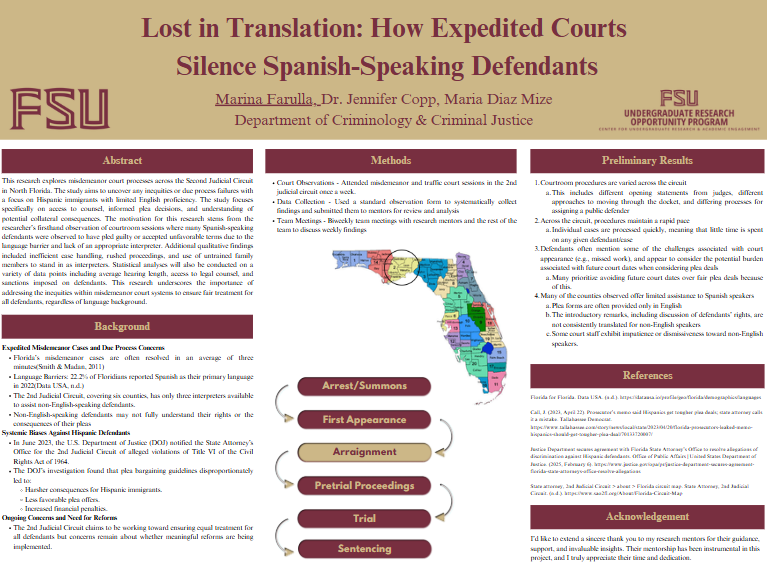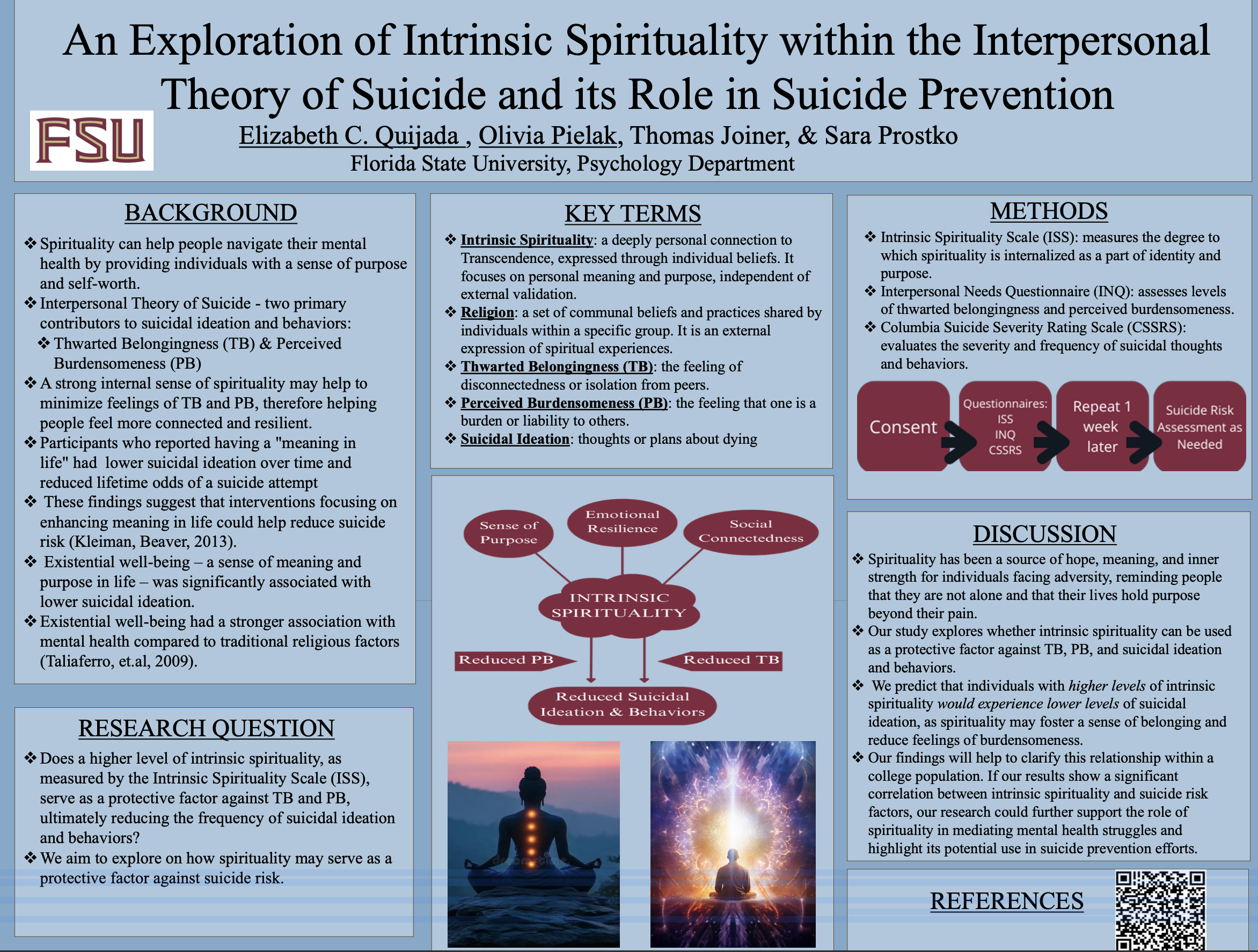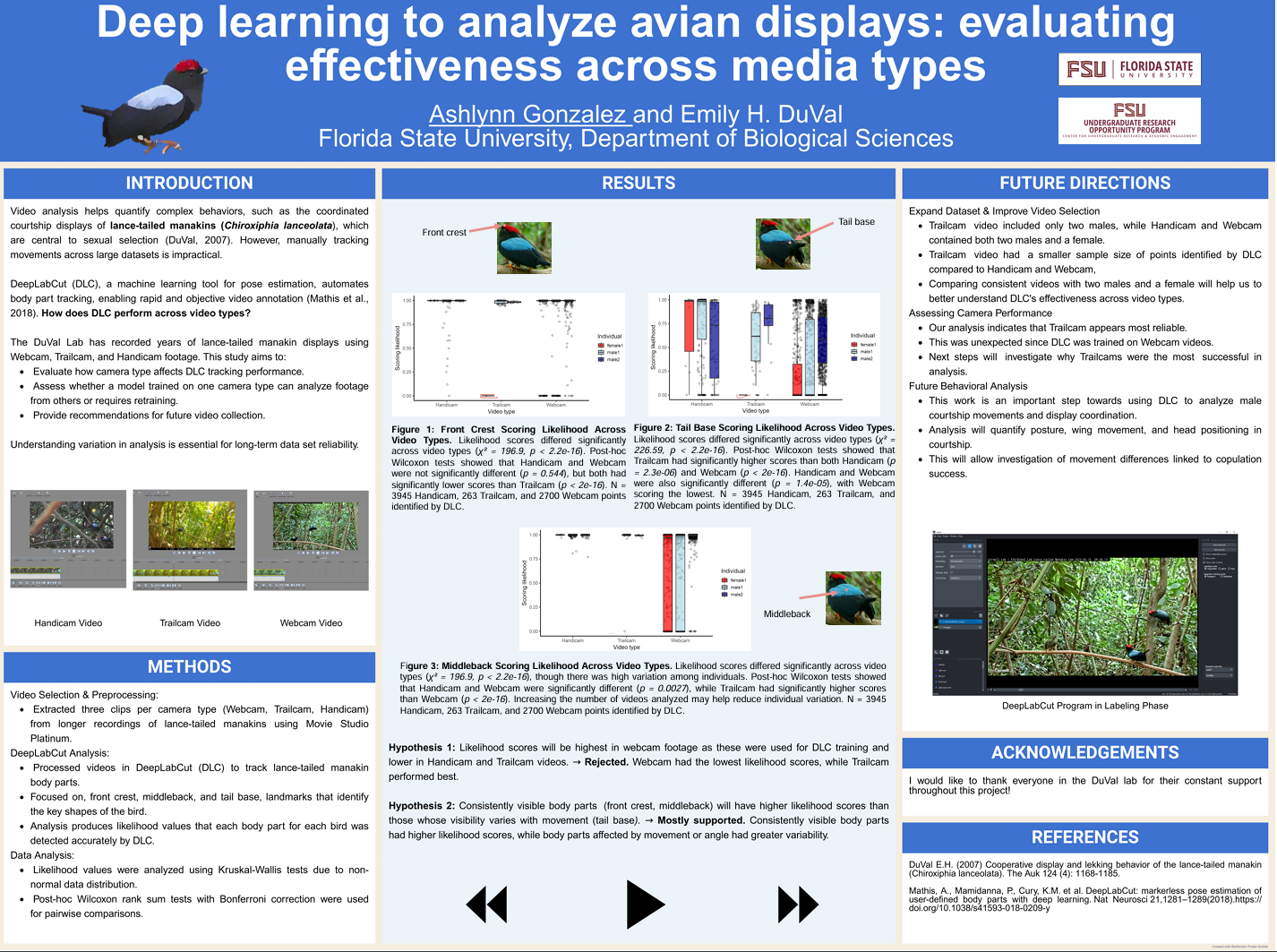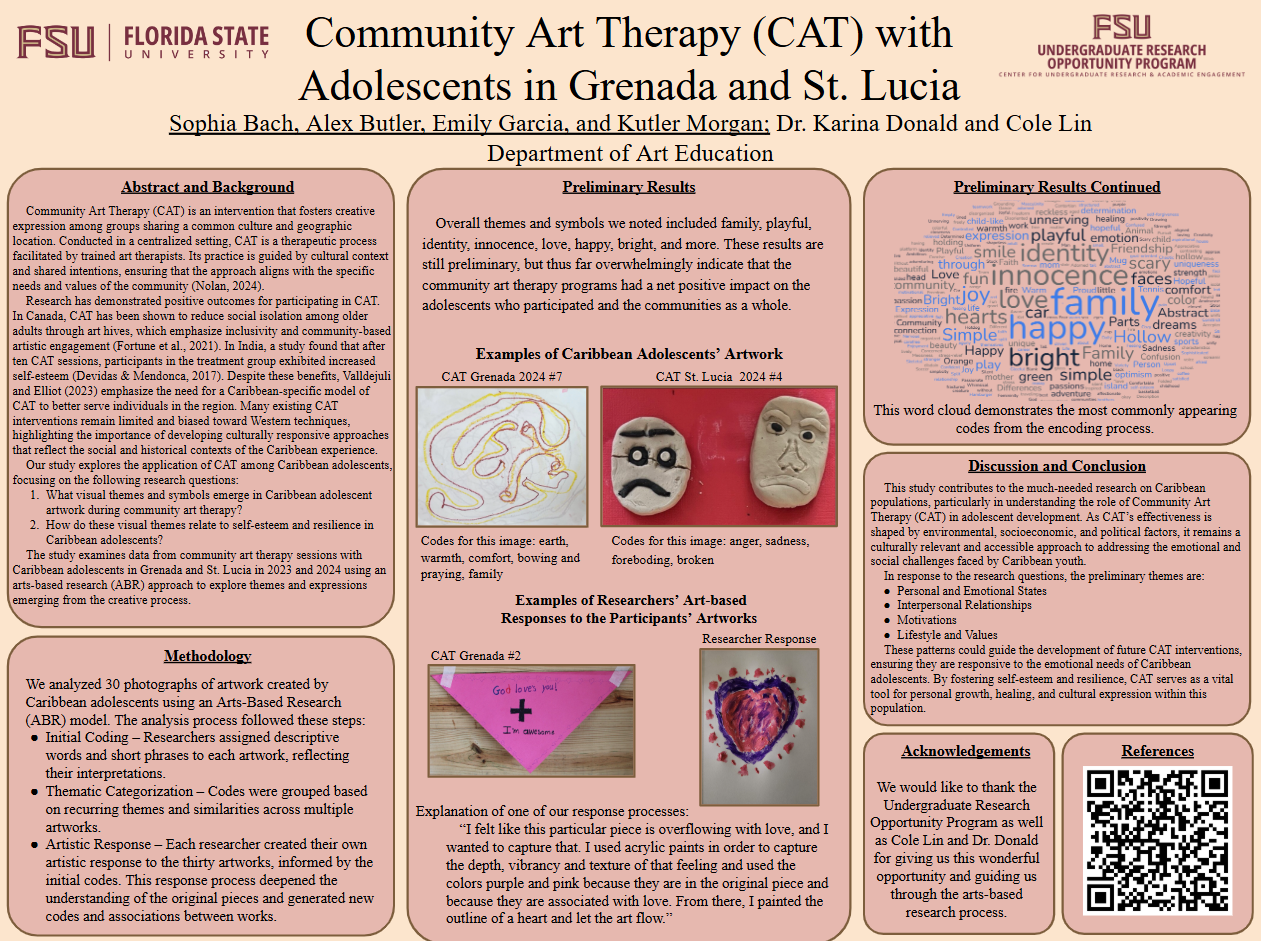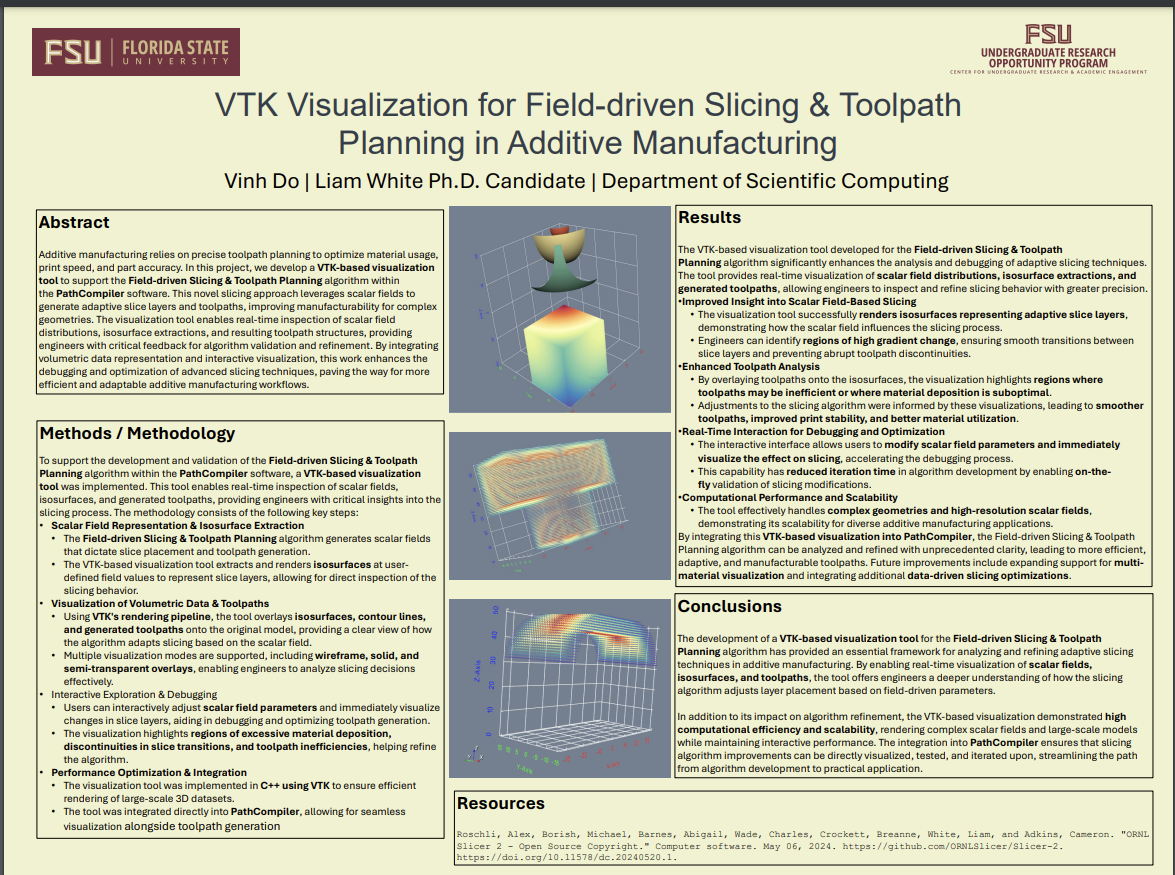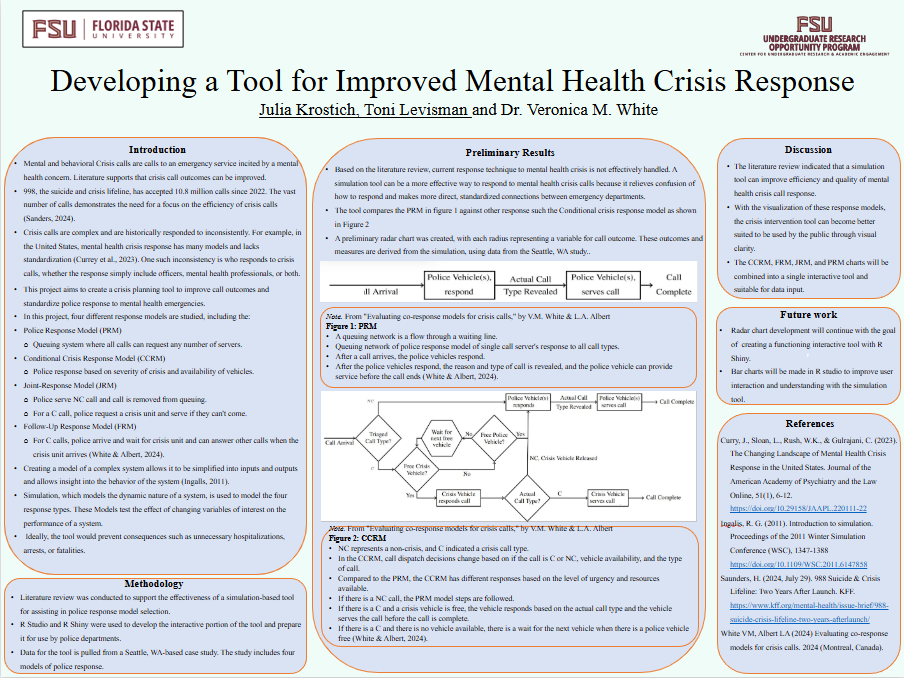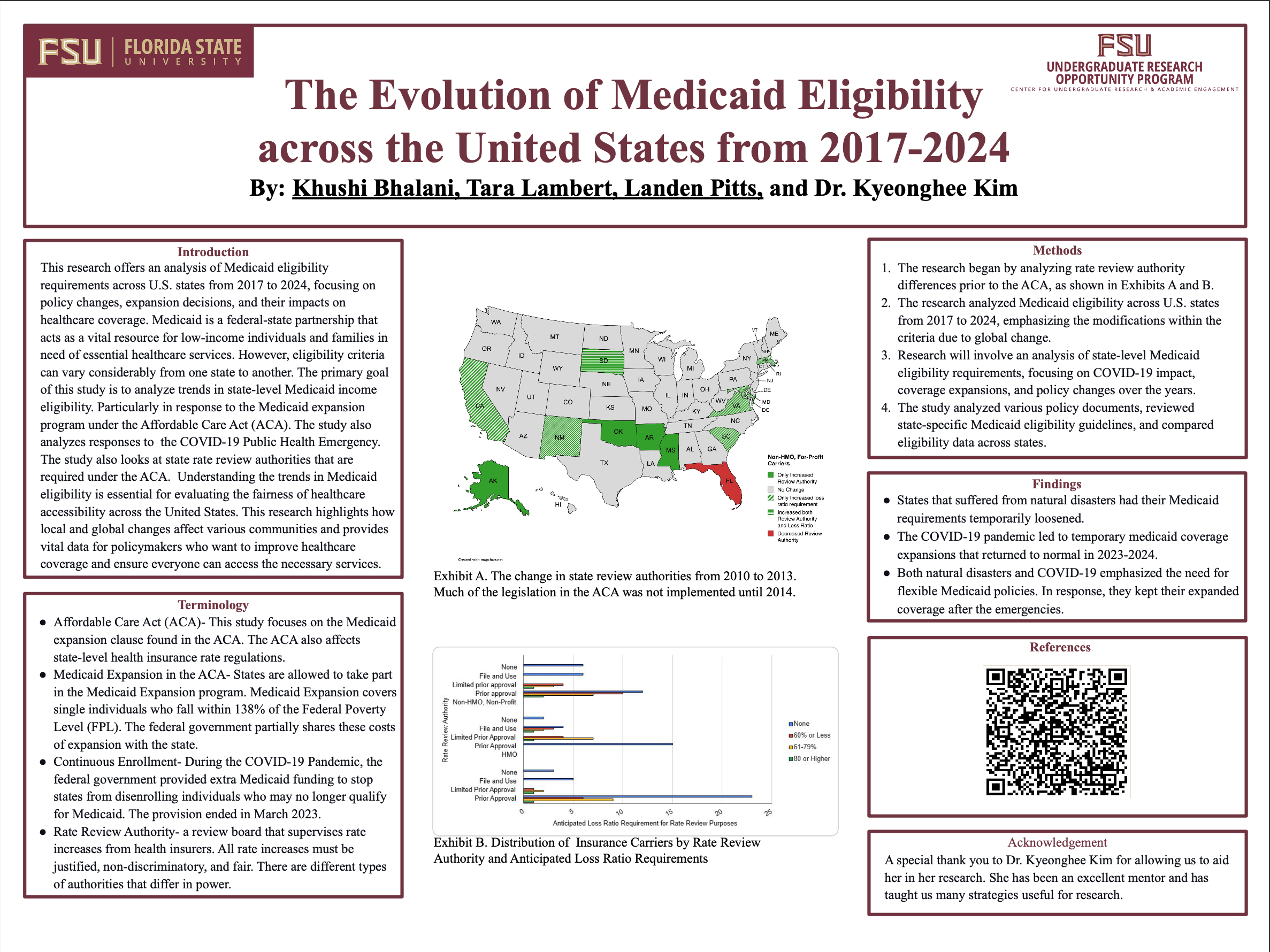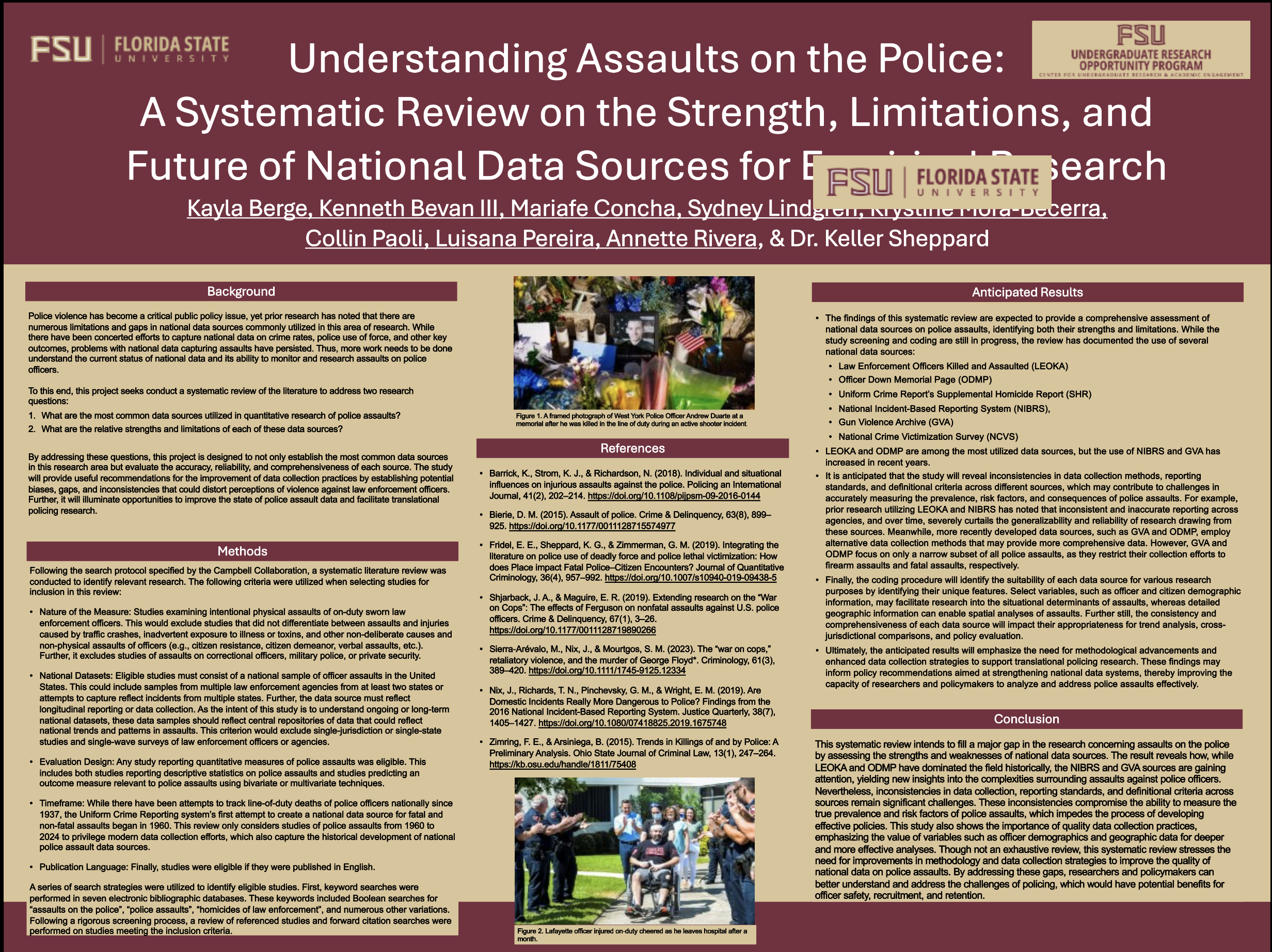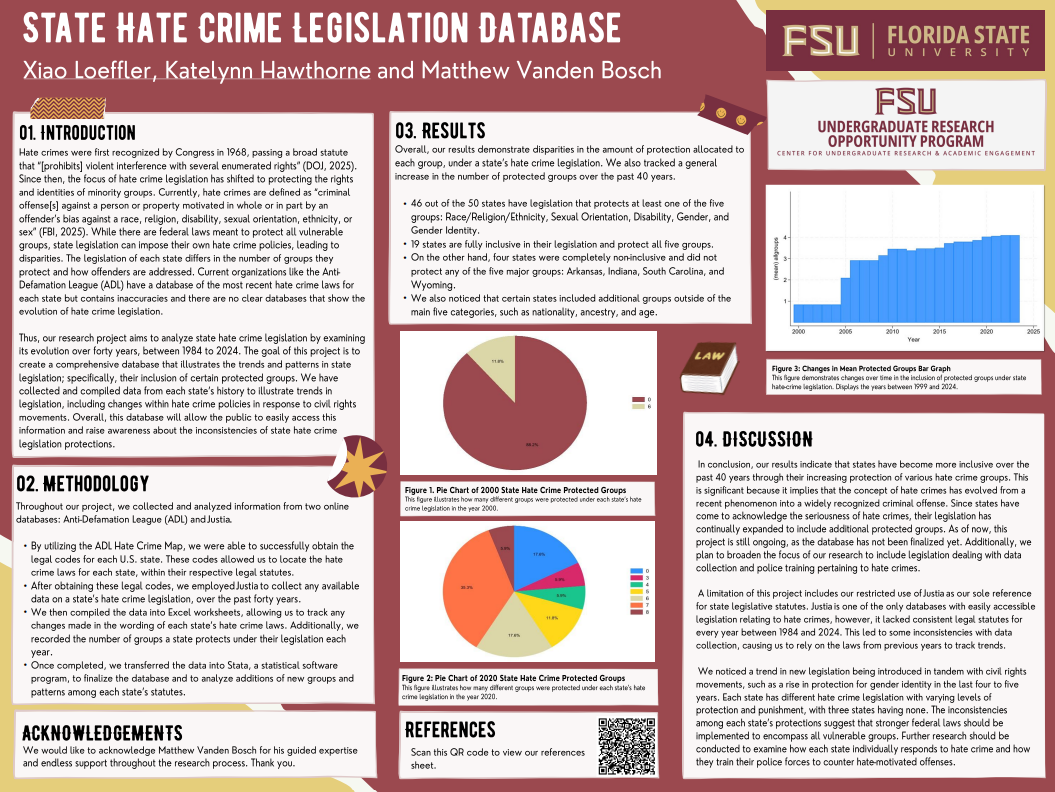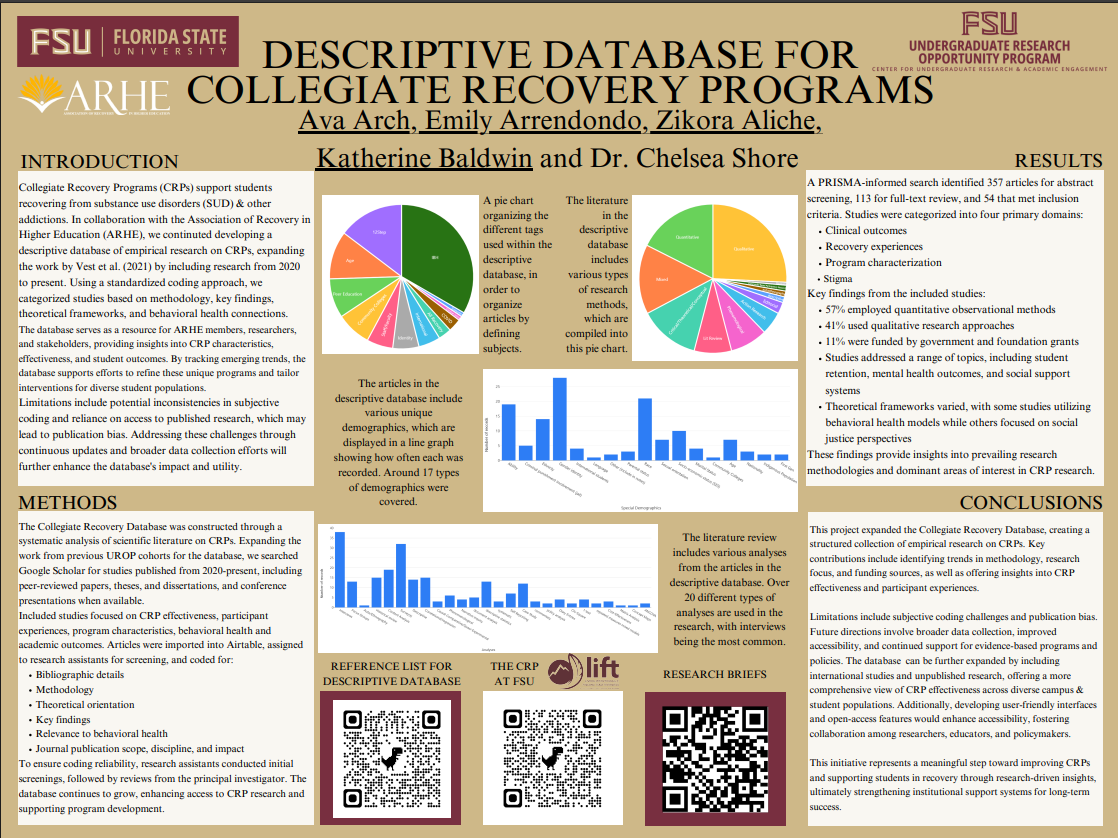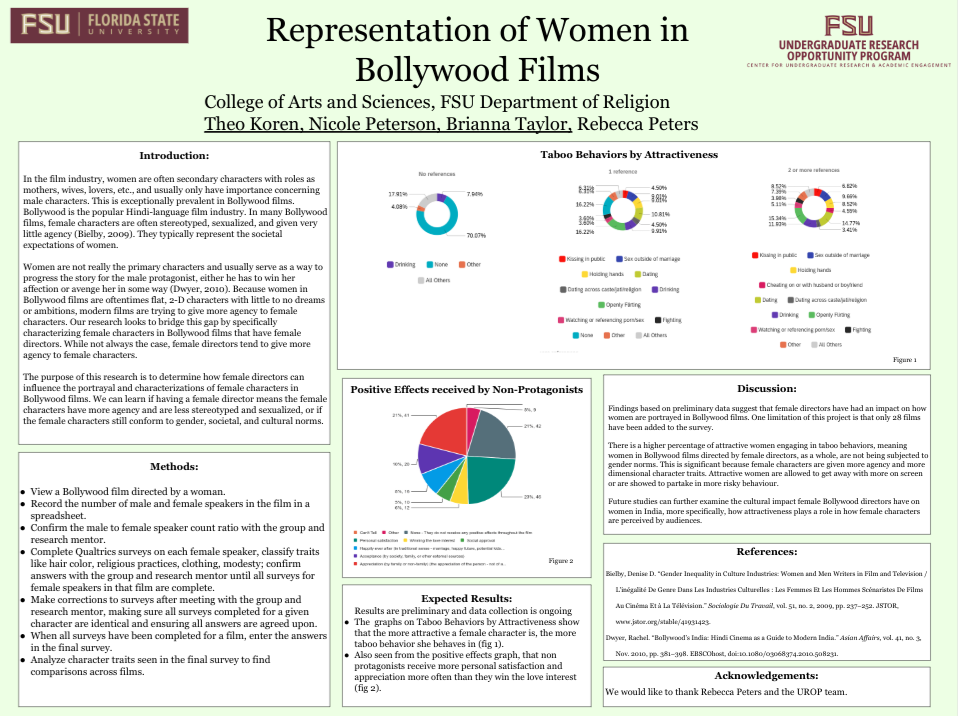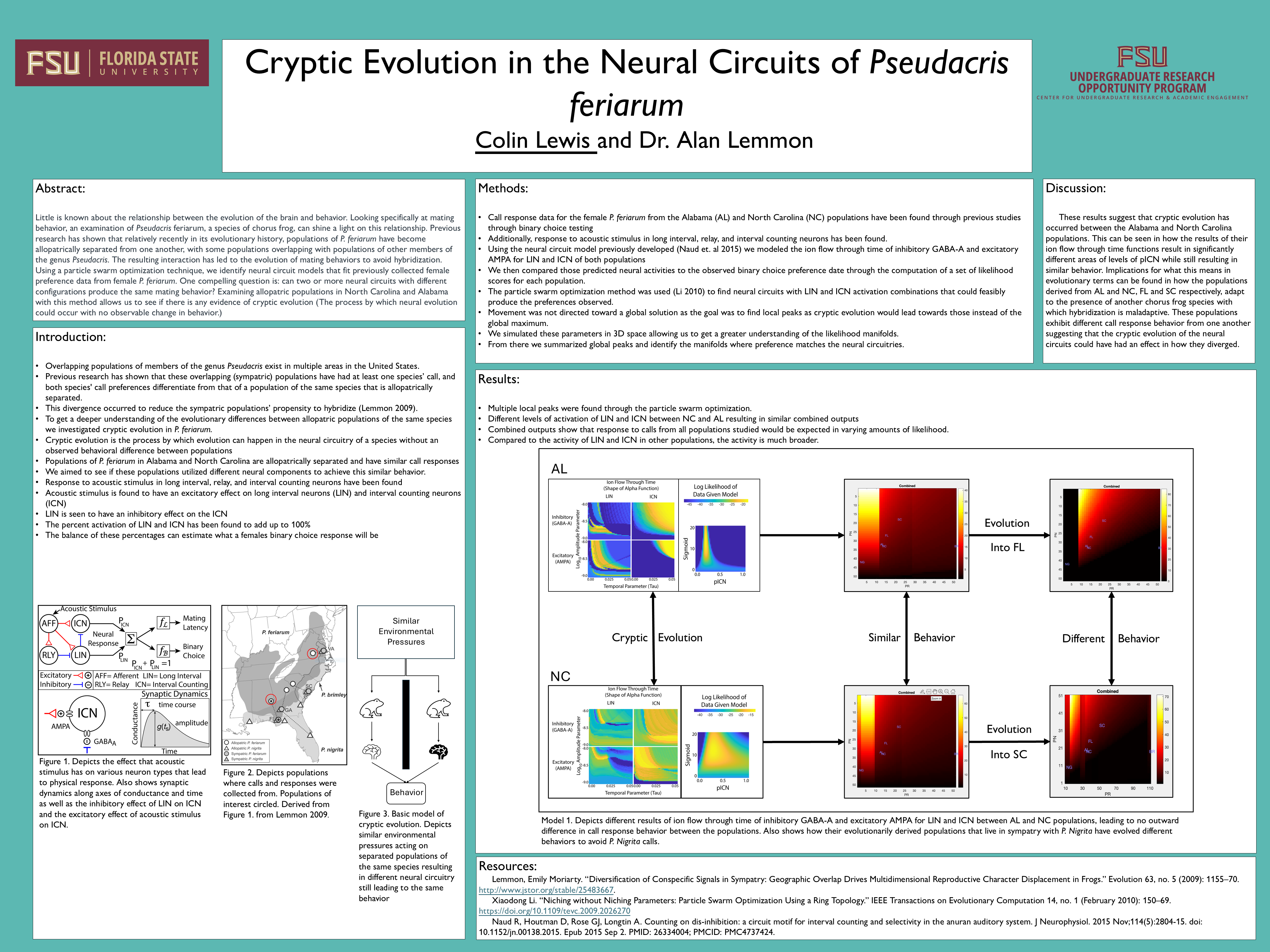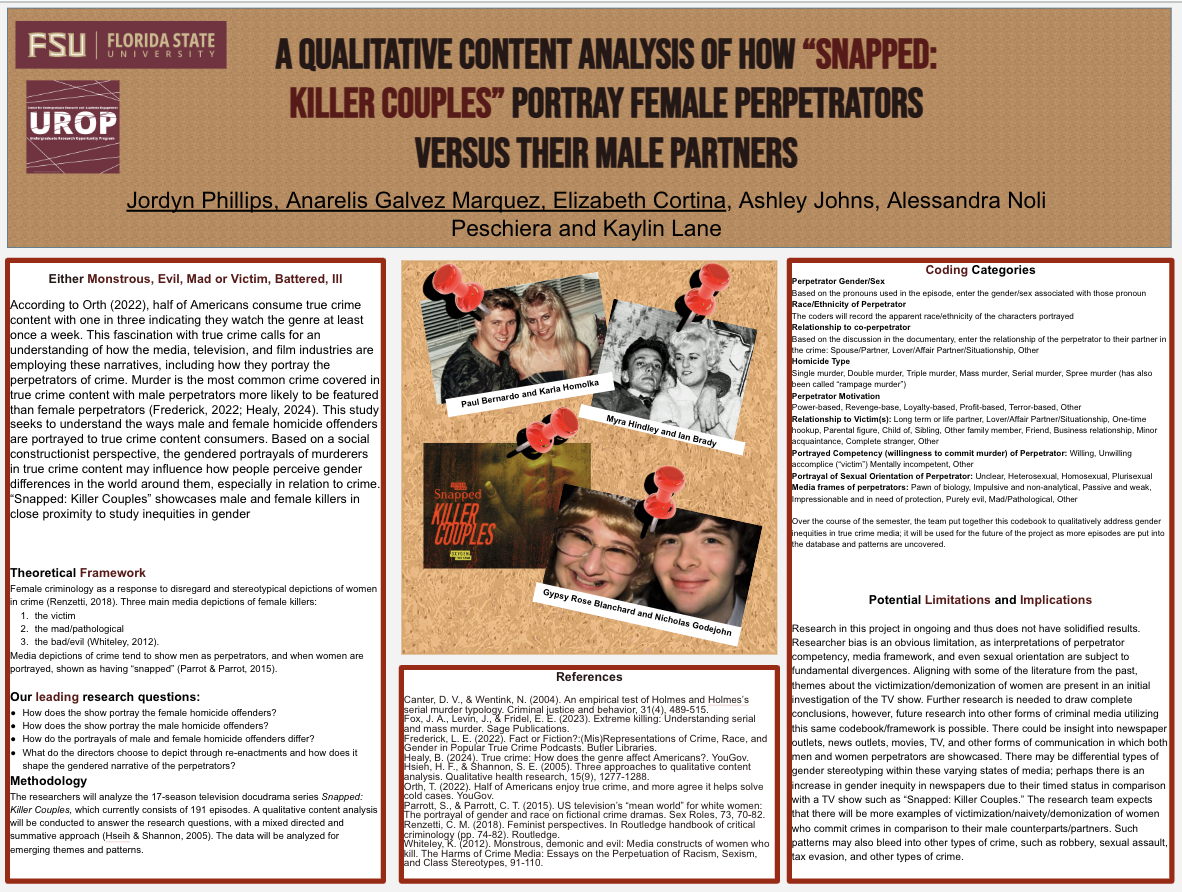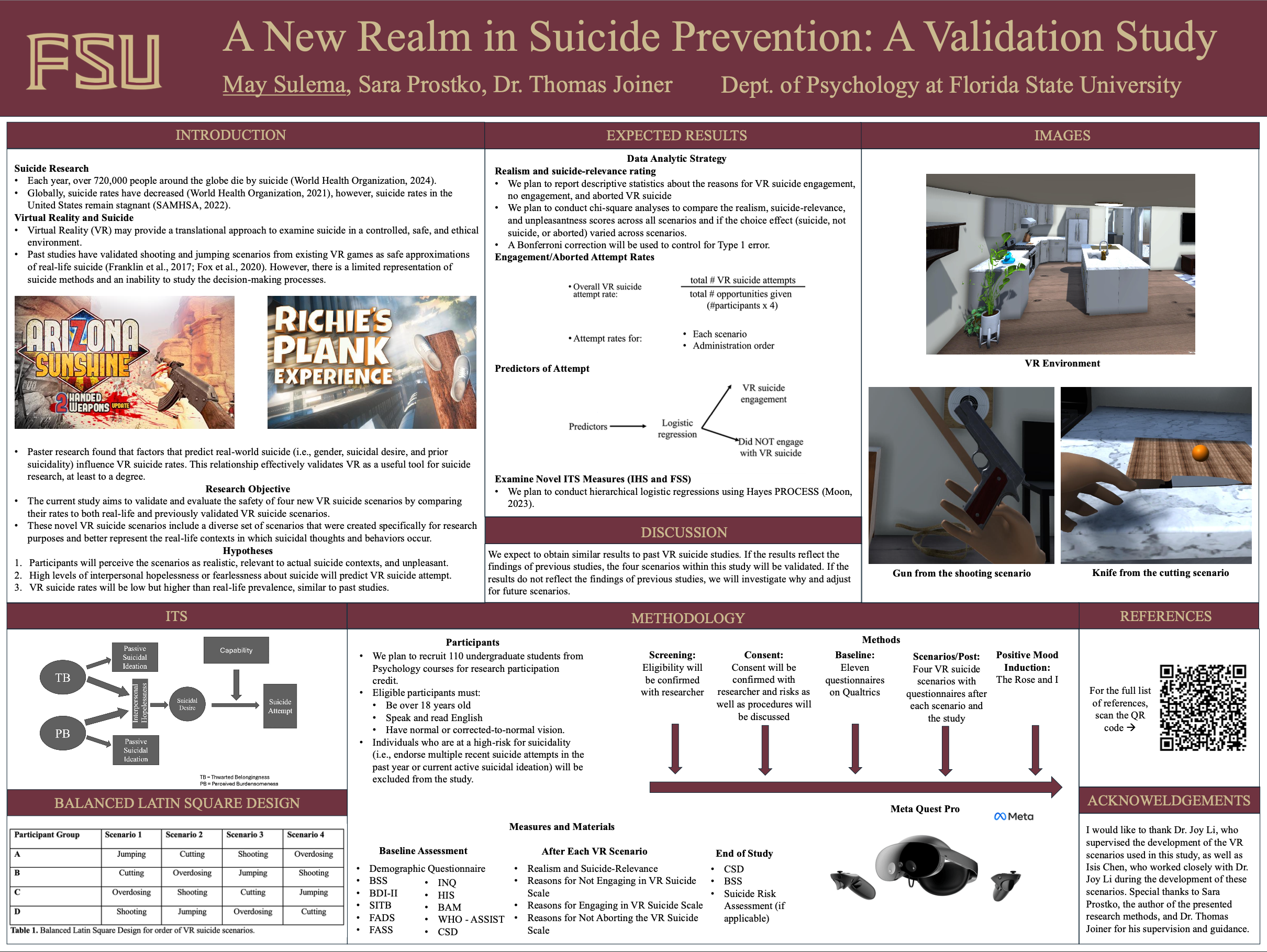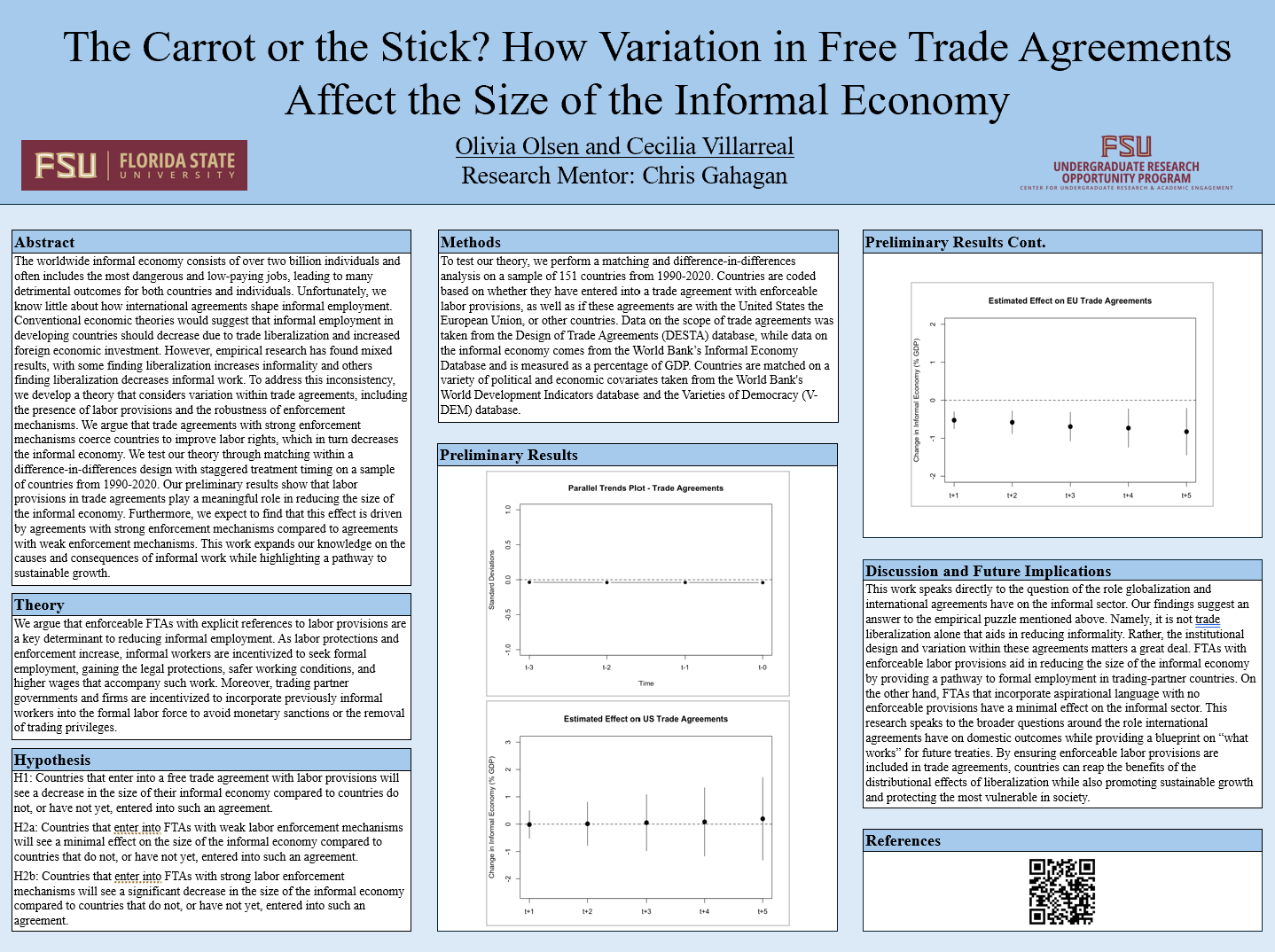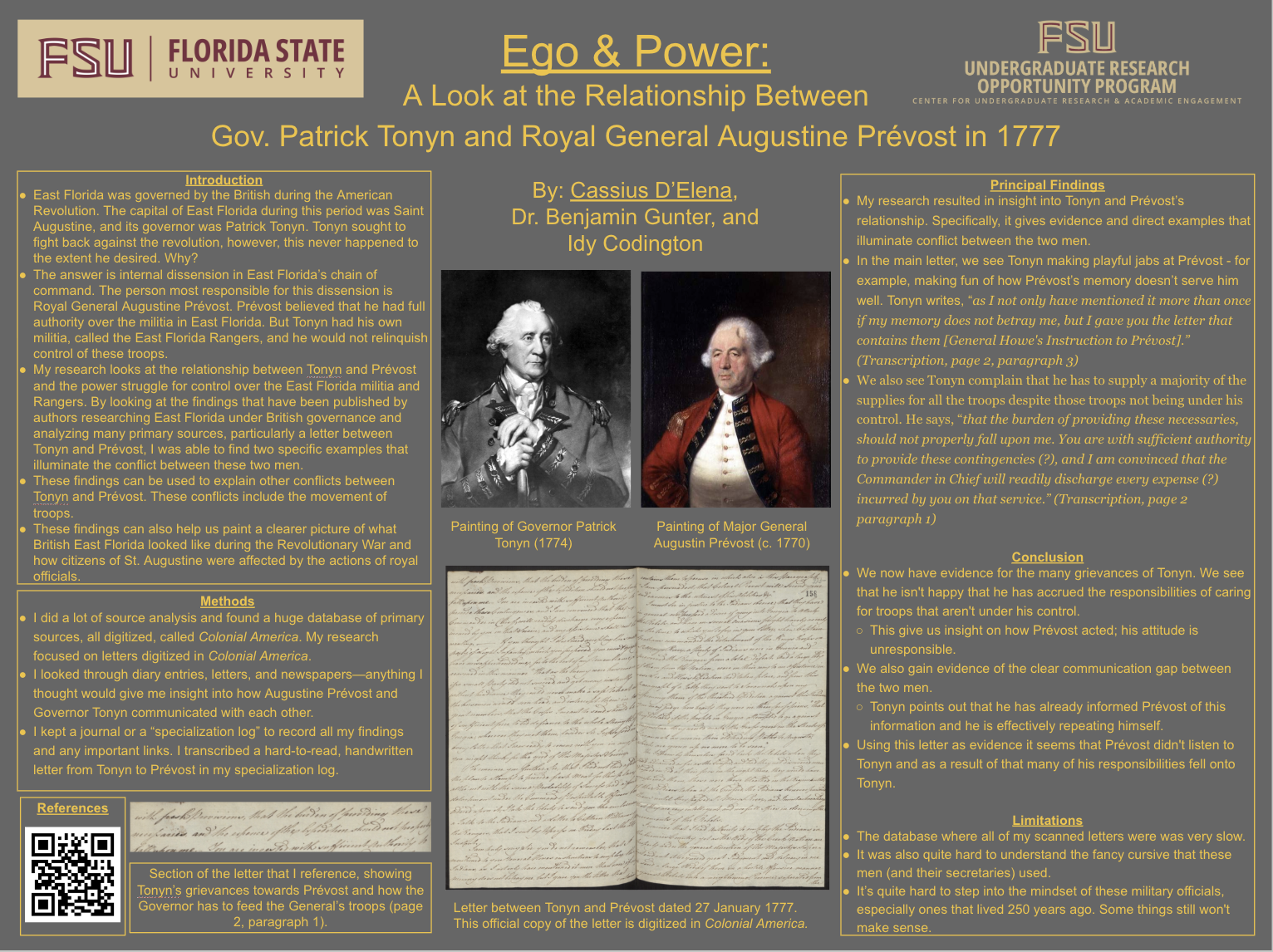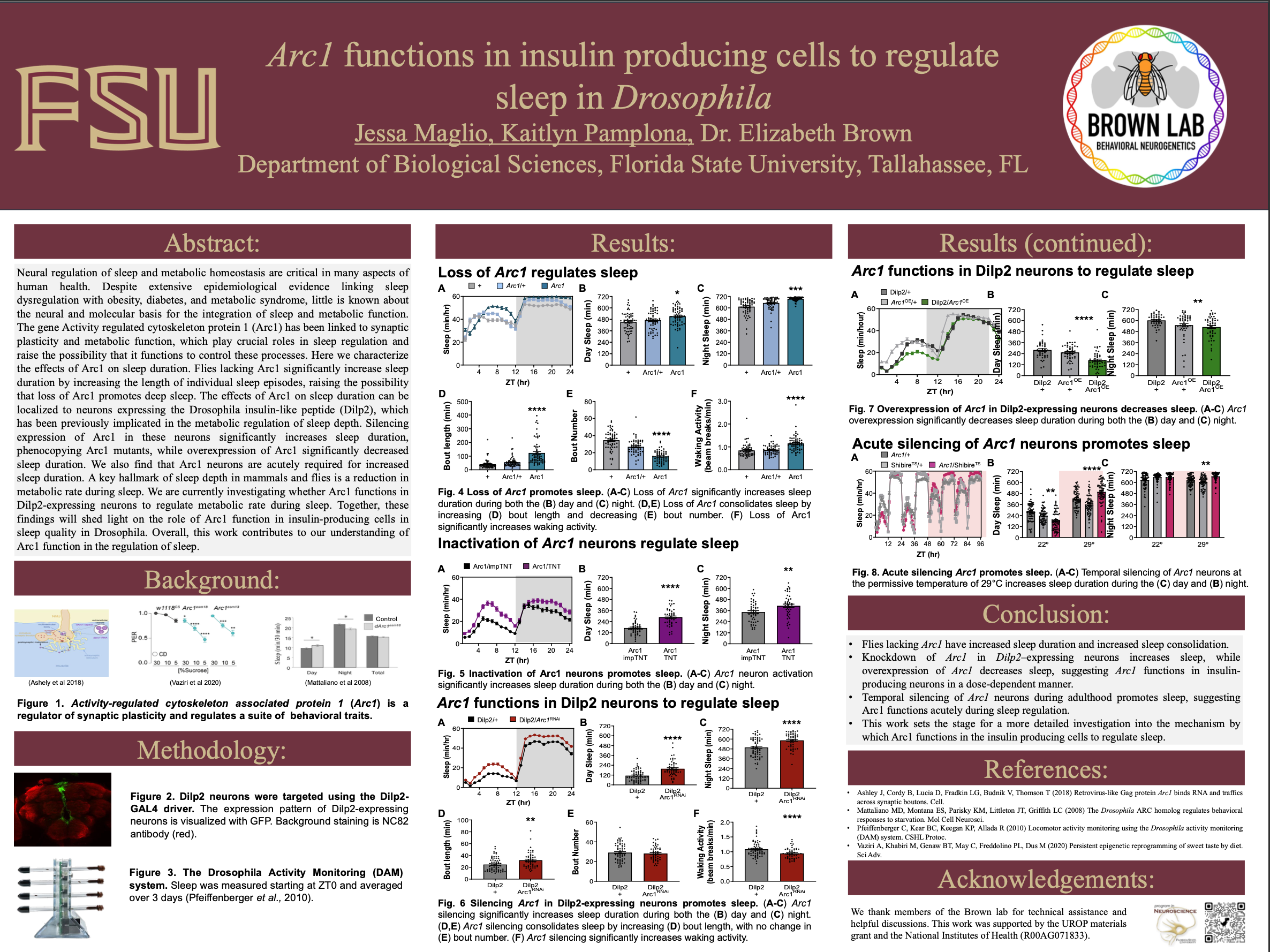Research Symposium
25th annual Undergraduate Research Symposium, April 1, 2025
Marina Farulla Poster Session 4: 3:00 pm - 4:00 pm/ Poster #140
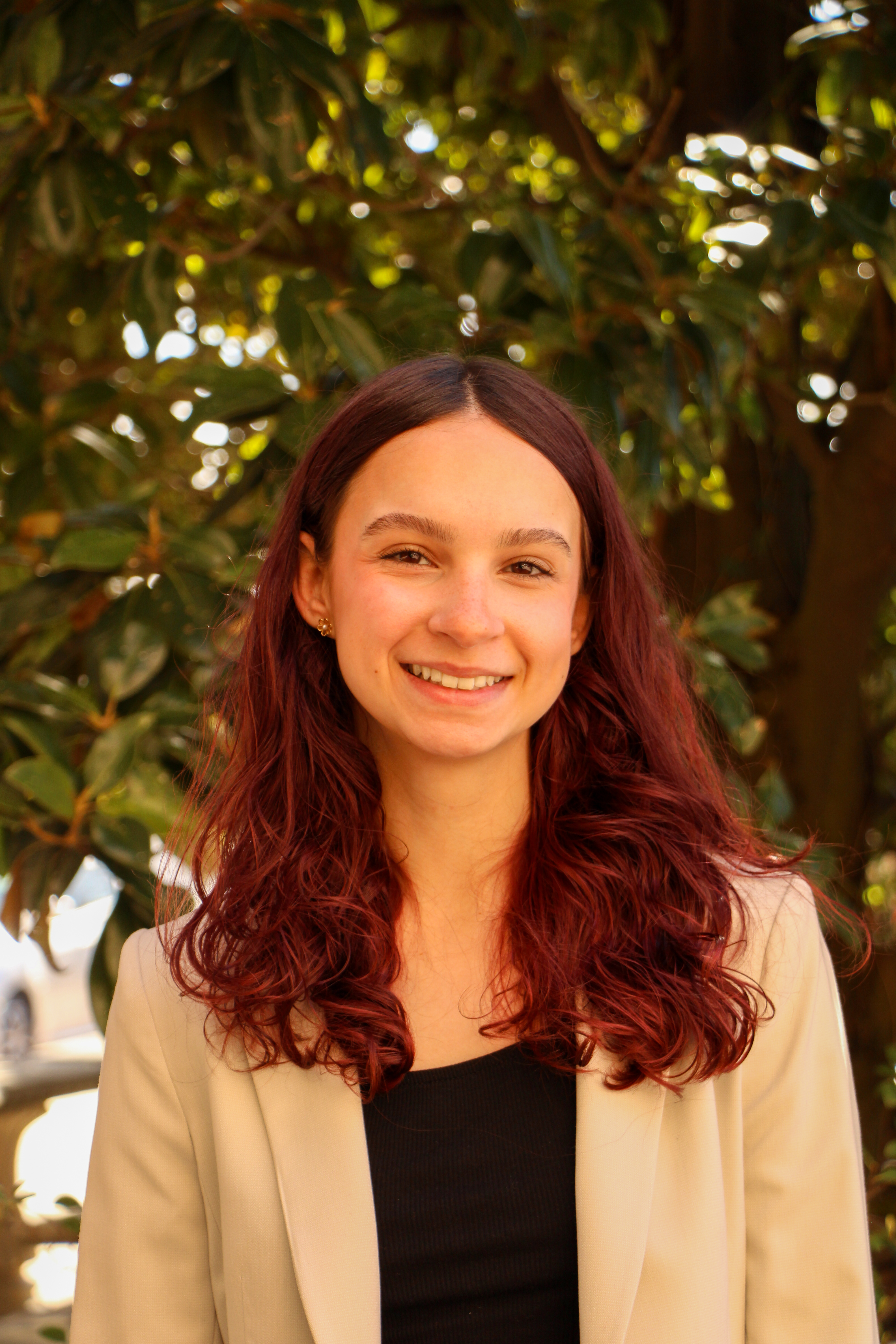
BIO
Marina Farulla is a first-year undergraduate student at Florida State University with a strong interest in criminology, law, and social justice. Growing up in a Hispanic household, they developed a personal awareness of the challenges non-English speakers face in legal settings. Passionate about equity and representation, they hope to use this research as a foundation for future work in law and public policy.
Lost in Translation: How Expedited Courts Silence Spanish-Speaking Defendants
Authors: Marina Farulla, Jennifer CoppStudent Major: Political Science & Psychology
Mentor: Jennifer Copp
Mentor's Department: Criminology & Criminal Justice Mentor's College: Criminology & Criminal Justice Co-Presenters:
Abstract
This research explores misdemeanor court processes across the Second Judicial Circuit in North Florida. The study aims to uncover any inequities or due process failures with a focus on Hispanic immigrants with limited English proficiency. The study focuses specifically on access to counsel, informed plea decisions, and understanding of potential collateral consequences. The motivation for this research stems from the researcher’s firsthand observation of courtroom sessions where many Spanish-speaking defendants were observed to have pled guilty or accepted unfavorable terms due to the language barrier and lack of an appropriate interpreter. Additional qualitative findings included inefficient case handling, rushed proceedings, and use of untrained family members to stand in as interpreters. Statistical analyses will also be conducted on a variety of data points including average hearing length, access to legal counsel, and sanctions imposed on defendants. This research underscores the importance of addressing the inequities within misdemeanor court systems to ensure fair treatment for all defendants, regardless of language background.
Keywords: Criminology, Law, Court Systems
25th annual Undergraduate Research Symposium, April 1, 2025
Elizabeth Quijada Poster Session 3: 1:45 pm - 2:45 pm/ Poster #4
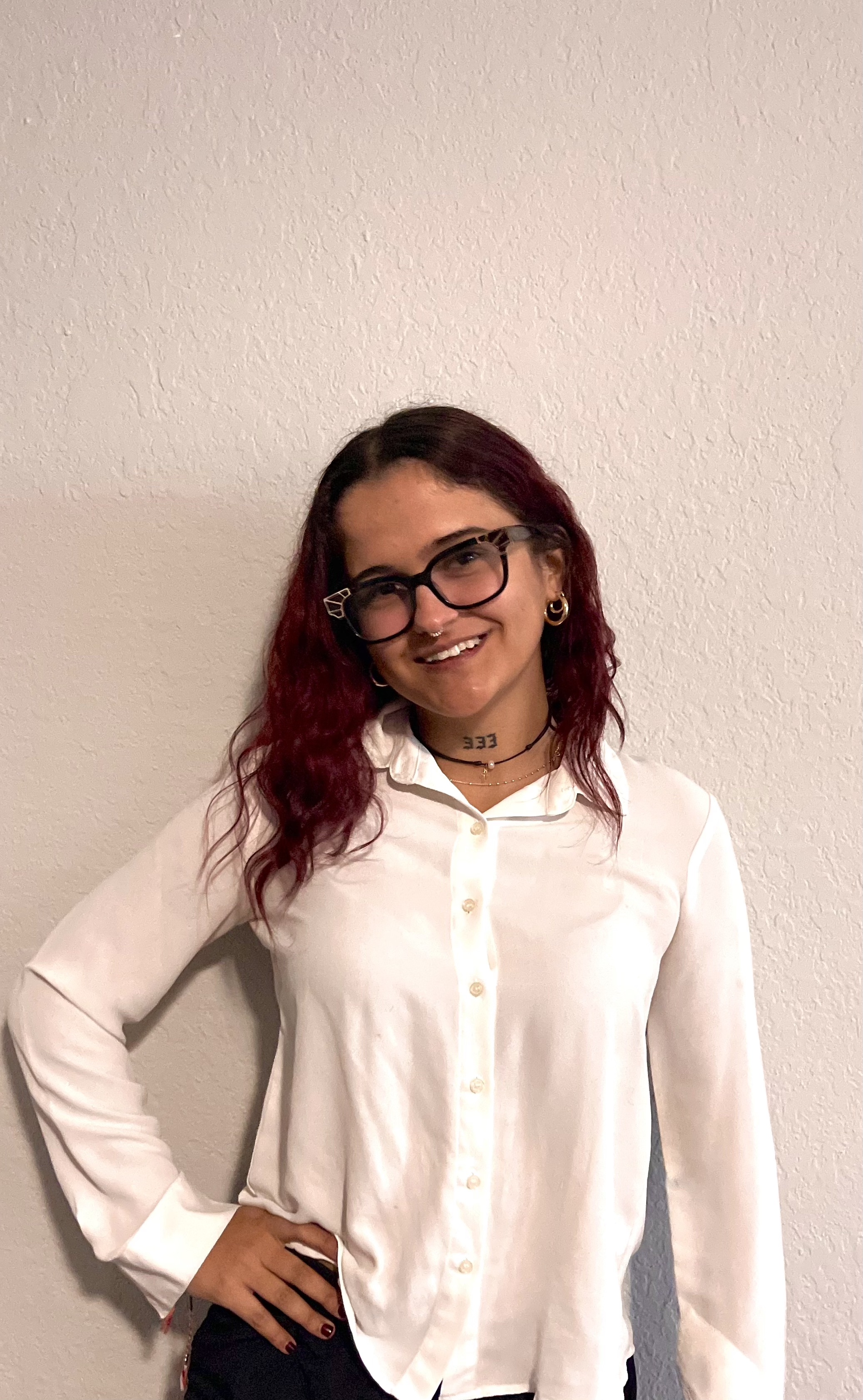
BIO
My name is Elizabeth Quijada, I was born in Venezuela but grew up in Miami, where I was exposed to diverse cultures and perspectives that shaped my passion for psychology. From a young age, I was fascinated by the complexities of human behavior, why we think, feel, and act the way we do. This curiosity led me to explore various aspects of psychology, particularly the ways in which our experiences and environments influence our decision making and well-being. As I pursued my studies, I developed a strong interest in addiction and rehabilitation, recognizing the profound impact that substance use disorders have on individuals and communities. Through research, I hope to contribute to advancements that improve recovery outcomes and help shape policies that promote more compassionate approaches to addiction treatment. I am excited to continue expanding my knowledge and gaining experience in the field, deepening my understanding of human behavior and the factors that influence mental health and recovery.
An Exploration of Intrinsic Spirituality within the Interpersonal Theory of Suicide and its Role in Suicide Prevention
Authors: Elizabeth Quijada, Sara ProstkoStudent Major: Psychology
Mentor: Sara Prostko
Mentor's Department: Psychology Mentor's College: College of Arts and Sciences Co-Presenters: Olivia Pielak
Abstract
Emerging evidence has suggested that spirituality, especially when internalized as an intrinsic value, plays a significant role in mental health resilience. The intrinsic spirituality construct represents a deep, personal belief in spiritual guidance and meaning in life that is not contingent on external aspects or validation. Prior studies have highlighted that spirituality can offer a sense of purpose, fostering inclusion that can enhance adaptive coping strategies in times of stress. Thwarted belongingness (TB), feelings of alienation and social disconnection, and perceived burdensomeness (PB), belief of being a liability to society and feelings of self-hatred have been linked to suicidal thoughts and behaviors via the Interpersonal Theory of Suicide (Joiner, 2005). Although past research has concentrated on risk factors for suicide, new research suggests that enhanced spiritual beliefs and practices can moderate the association between social disconnection and suicidal outcomes. Notably, studies such as those by Kleiman and Beaver (2013) and Taliaferro, et.al (2009) have underscored the beneficial role of spirituality in reducing psychological distress and suicide risk. This study aims to demonstrate how individuals with higher levels of intrinsic spirituality, measured by the Intrinsic Spirituality Scale (ISS), exhibit stronger protective factors against TB and PB, leading to lower frequencies of suicidal ideation and behaviors. Participants will complete two sessions about one week apart where they complete questionnaires on intrinsic spirituality, TB, PB, and suicidal thoughts and behaviors. We expect for higher levels of intrinsic spirituality to protect against TB, PB, and suicidal thoughts and behaviors.
Keywords: Spirituality, Risk Reduction, Interpersonal Theory of Suicide
25th annual Undergraduate Research Symposium, April 1, 2025
Ashlynn Gonzalez Poster Session 2: 10:45 am - 11:45 am/ Poster #10

BIO
Ashlynn is a second-year student double majoring in Biology and FSU Teach at Florida State University. Her upbringing in Lutz, Florida, showing livestock and mentoring younger students through FFA sparked her passion for both agriculture and education. She is pursuing a career in either large animal veterinary medicine or agricultural education. Her broader research interests include animal behavior, plant science, and agricultural systems. She is particularly interested in how scientific research can support sustainable farming and animal welfare, as well as help people better understand where their food comes from.
Deep learning to analyze avian displays: evaluating effectiveness across media types
Authors: Ashlynn Gonzalez, Dr. Emily H. DuValStudent Major: Biology/FSU-Teach
Mentor: Dr. Emily H. DuVal
Mentor's Department: Biological Science Mentor's College: College of Arts and Sciences Co-Presenters:
Abstract
The multifaceted nature of courtship displays makes it difficult to identify components most relevant to the animals involved. Video analysis provides new opportunities to understand male lance-tailed manakin (Chiroxiphia lanceolata) displays. DeepLabCut (DLC), a machine learning tool for pose estimation, automates body part tracking, enabling rapid and objective video annotation. Long-term study of this species in the DuVal Lab has generated years of footage, but recording media has changed over time. This study evaluates DLC’s confidence in detecting body parts across three video types—Handicam, Trailcam, and Webcam—to assess how camera quality affects tracking performance. We manually labeled body parts to train the model and analyzed likelihood scores for the frontcrest, middleback, and tail base. Kruskal-Wallis tests revealed that Trailcam footage produced the highest likelihood scores overall, despite not being used in model training. Webcam and Handicam footage had lower scores, with the tail base scoring lowest across all types. These results suggest that video quality and body part visibility significantly influence DLC performance. By refining methods for studying dynamic behaviors, this research enhances our understanding of how sexual selection shapes social interactions and informs future data collection strategies in behavioral ecology.
Keywords: Animal Behavior, Avian, Ecology, Deep Learning
25th annual Undergraduate Research Symposium, April 1, 2025
Kutler Morgan Poster Session 1: 9:30 am - 10:30 am/ Poster #255

BIO
Hello I am Kutler Morgan! I am a second year student here at FSU majoring in Psychology. I am from Panama City Florida and completed my first year at the Panama City Campus. Among psychology, I am interested in interactions with new technology like social media, school psychology, and social psychology. I plan on going to graduate school to become a school psychologist.
Community Art Therapy (CAT) with Adolescents in Grenada and St. Lucia
Authors: Kutler Morgan, Karina DonaldStudent Major: Psychology
Mentor: Karina Donald
Mentor's Department: Department of Art Education Mentor's College: College of Fine Arts Co-Presenters: Sophia Bach, Alex Butler, and Emily Garcia
Abstract
This study explores the effectiveness of community art therapy (CAT) in Caribbean adolescent populations and to what extent their artworks demonstrate self-esteem and resilience. Community Art Therapy is the practice of conducting group sessions of art therapy in the context of different cultures and clients. Art therapy-based studies have been conducted in several cultures, but studies of CAT with Caribbean populations, especially adolescents, are limited. Therefore, our study asks (1) What visual themes and symbols depict Caribbean adolescent art during CAT? And (2) How do visual themes in Caribbean adolescents' artwork from CAT relate to self-esteem and resilience? Previous research has indicated that CAT is often beneficial for adolescents (Devidas & Mendonca, 2017; Sutherland et al., 2010). Art therapy can bring out expressions and emotions that more traditional therapy techniques may struggle with. CAT sessions were conducted in the Caribbean islands of Grenada and St. Lucia between 2023 and 2024, and 30 photos of artwork were collected from Caribbean adolescents. The arts-based research (ABR) model was used to inquire on the Caribbean adolescents’ artwork by trained researchers. The process involves analyzing the qualitative visual arts through creating our own art in response to get a better understanding of the data. Preliminary findings indicate that Caribbean adolescents’ artworks include themes of family, goals, joy, simplicity, brightness, and more, although some works expressed less positive themes. Overall, findings demonstrated the effectiveness of CAT in fostering emotion expression. Future research should expand upon the treatment of CAT in Caribbean islands and other populations.
Keywords: Art Therapy, Caribbean, Arts-Based Research
25th annual Undergraduate Research Symposium, April 1, 2025
Vinh Do Poster Session 2: 10:45 am - 11:45 am/ Poster #265

BIO
My name is VInh Do and I am a student majoring in Computer Science at FSU from Vietnam. My research interest is in Computer Science and Mathematics related subjects.
VTK Visualization for Field-driven Slicing & Toolpath Planning in Additive Manufacturing
Authors: Vinh Do, Liam WhiteStudent Major: Computer Science
Mentor: Liam White
Mentor's Department: Department of Scientific Computing Mentor's College: Florida State University Co-Presenters:
Abstract
Additive manufacturing relies on precise toolpath planning to optimize material usage,
print speed, and part accuracy. In this project, we develop a VTK-based visualization
tool to support the Field-driven Slicing & Toolpath Planning algorithm within
the PathCompiler software. This novel slicing approach leverages scalar fields to
generate adaptive slice layers and toolpaths, improving manufacturability for complex
geometries. The visualization tool enables real-time inspection of scalar field
distributions, isosurface extractions, and resulting toolpath structures, providing
engineers with critical feedback for algorithm validation and refinement. By integrating
volumetric data representation and interactive visualization, this work enhances the
debugging and optimization of advanced slicing techniques, paving the way for more
efficient and adaptable additive manufacturing workflows
Keywords: Toolpath, Compiler, C++
25th annual Undergraduate Research Symposium, April 1, 2025
Julia Krostich Poster Session 1: 9:30 am - 10:30 am/ Poster #141
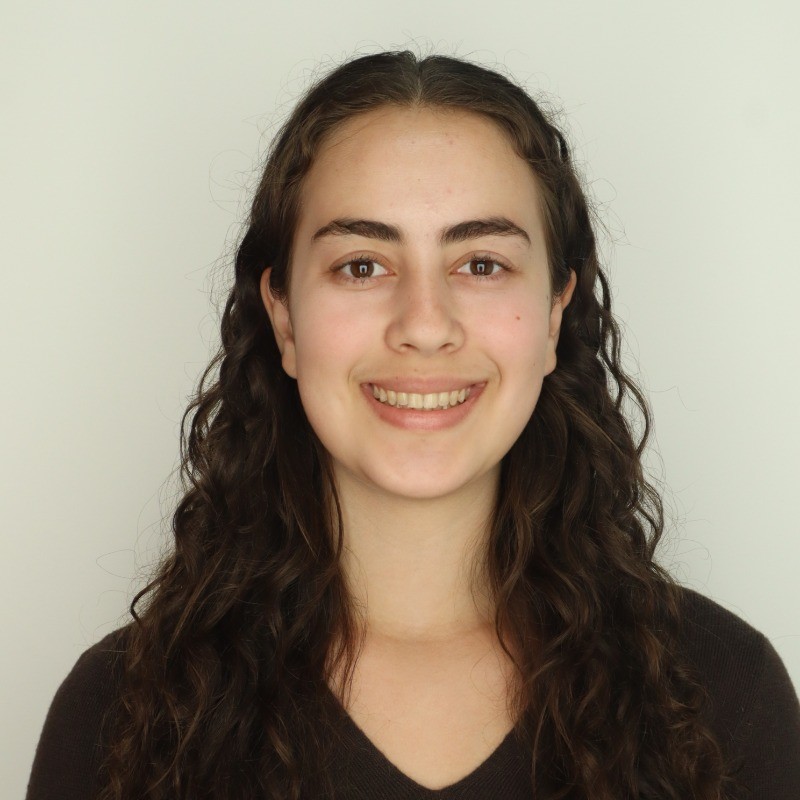
BIO
My name is Julia Krostich, and I am a second-year pre-nursing student at Florida State University, originally from Lake Worth, Florida. I aspire to become a nurse, and involvement in research has been a beneficial experience. I have learned a lot about police response to mental health crises and am interested in continuing this research to create a tool to improve the efficiency of the intervention. With an interest in mental health, I understand the importance of having accessible systematic tools for users.
Developing a Tool for Improved Mental Health Crisis Response
Authors: Julia Krostich, Dr. Veronica M. WhiteStudent Major: NFA-Nursing
Mentor: Dr. Veronica M. White
Mentor's Department: Industrial and Manufacturing Engineering Mentor's College: FAMU-FSU College of Engineering Co-Presenters: Toni Levisman
Abstract
Police response to mental health crisis calls can lead to adverse outcomes. A crisis call is a call to an emergency service during an emergency inflicted by a mental health concern. This project aims to develop a simulation-based tool, which models the dynamic nature of police response based on user inputs to evaluate their system performance in different crisis response models. The tool aims to improve the planning of response to crisis calls and improve mental health outcomes. Ideally, it would prevent consequences such as unnecessary hospitalizations, arrests, or fatalities. A literature review of existing attempts to improve police response to mental health crises was conducted to improve understanding of the benefit of the simulation tool. Data visualization was used to interpret data from a Washington-based case study. A user interface for the tool is in development for the use of interaction by potential users. Based on our preliminary literature review, it is likely that the tool would improve mental health crisis call outcomes. Ideally, the tool would assist in deciding the most effective call response model. Future honing could mold the tool to specific community conditions as well as improve user interaction.
Keywords: Mental health, police, emergency, tool, crisis response, queue
25th annual Undergraduate Research Symposium, April 1, 2025
Khushi Bhalani Poster Session 3: 1:45 pm - 2:45 pm / Poster #171

BIO
Hello! My name is Khushi Bhalani, and I am a second-year Honors student in the College of Business at Florida State University, majoring in Business Management. After graduation, I plan to attend law school and pursue a career in corporate law.
The Evolution of Medicaid Eligibility across the United States from 2017-2024
Authors: Khushi Bhalani, Dr. Kyeonghee KimStudent Major: Business Management
Mentor: Dr. Kyeonghee Kim
Mentor's Department: Department of Risk Management/Insurance, Real Estate and Legal Studies Mentor's College: College of Business Co-Presenters: Tara Lambert and Landen Pitts
Abstract
This research project examines how Medicaid eligibility in the U.S. changed from 2017 to 2024, focusing on how recent global events have impacted the healthcare system. The research question guiding this study is: How was Medicaid eligibility affected over the years in the U.S.? Investigating this question is an important part of understanding how events such as the COVID-19 pandemic, shifts in political leadership, and natural disasters have influenced access to healthcare for low-income populations. My research team and I collected Medicaid eligibility data from official state websites to answer this question, gathering information on all 50 states. By analyzing changes in eligibility criteria—including income thresholds, residency status, social security status, etc.—this study identifies patterns and key factors influencing Medicaid access. The research project findings suggest that Medicaid eligibility fluctuated in response to local events and global changes like political leadership changes, economic shifts, and major crises like the COVID-19 pandemic. Some states expanded access to Medicaid, while others imposed stricter criteria, reflecting broader national debates on healthcare policy. The results emphasize the crucial influence of external events on how states formulate their Medicaid policies, highlighting the necessity for adaptable healthcare strategies that guarantee ongoing access to vital medical services during crises. This research is a fraction of the broader conversation about healthcare reform, stressing the importance of upholding a flexible and fair Medicaid system amidst global change.
Keywords: Insurance, Medicaid, ACA
25th annual Undergraduate Research Symposium, April 1, 2025
Sydney Lindgren Poster Session 2: 10:45 am - 11:45 am/ Poster #163
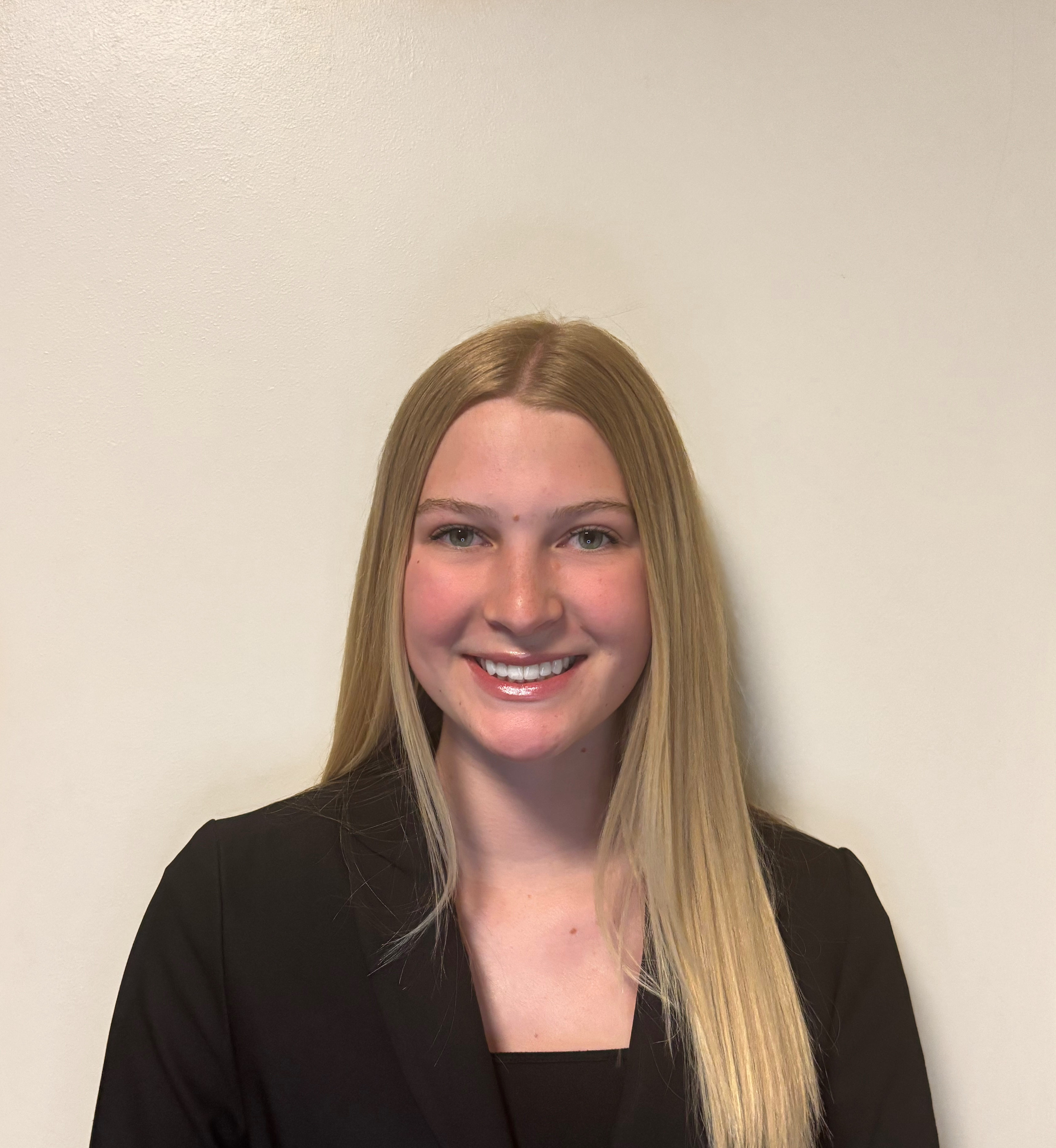
BIO
My name is Sydney Lindgren and I am from Bonita Springs, Florida. I am a first-year student studying Behavioral Neuroscience with minors in Biology and Chemistry. I look forward to entering the healthcare field as a Physician Assistant specializing in emergency medicine after graduation. I am involved in research for the College of Criminology and Criminal Justice regarding the strenghts and limitations of police assault data in different data sets. My research interests are in criminology and behavioral sciences. Other than my research, I am involved in the Pre-PA club, AED Pre-Health Honor Society, Presidential Scholars, and Dance Marathon.
Understanding Assaults on the Police: A Systematic Review on the Strength, Limitations, and Future of National Data Sources for Empirical Research
Authors: Sydney Lindgren, Keller SheppardStudent Major: Behavioral Neuroscience
Mentor: Keller Sheppard
Mentor's Department: Criminology and Justice Policy Mentor's College: College of Criminology and Criminal Justice Co-Presenters: Kayla Berge, Kenneth Bevan III, Mariafe Concha, Krystine Mora-Becerra, Collin Paoli, and Luisana Pereira
Abstract
Assaults on the police represent a pressing public policy issue, especially as law enforcement faces challenges in recruitment and retention due to the unique occupational dangers associated with policing. A growing body of empirical research has sought to understand the prevalence, risk factors, and consequences of these incidents; however, its development is complicated by the limitations of national data sources on police assaults. The aim of this systematic literature review is threefold: (1) assess the prevalence of each national data source on police assaults, (2) synthesize the limitations of these data sources as detailed in prior research, and (3) describe the unique feature of each data source that can facilitate future research. To this end, searches of literature published from January 1960 to September 2024 were performed using a combination of search strategies, such as electronic database searches, reference searches, and forward citation searches. Studies will be screened against a set of inclusion criteria and coded to address the study’s three key research questions. It is anticipated that the results of this study will highlight the key strengths and limitations of current national data on this crucial public policy issue. Further, it will illuminate opportunities to improve the state of police assault data and facilitate translational policing research.
Keywords: Police, Assault, Public Policy,
25th annual Undergraduate Research Symposium, April 1, 2025
Xiao Loeffler Poster Session 2: 10:45 am - 11:45 am/ Poster #231

BIO
Hi, my name is Xiao Loeffler and I am a first year at FSU. I plan on pursuing a dual degree in criminology and psychology, with goals of joining the FBI or a career in crime analysis. This research project is something I'm particularly passionate about, as I believe it's important for there to be adequate protection for all vulnerable groups and for more people to be fully aware of these rights. Hate crimes often go underreported and it can be difficult to acquire accurate data on the frequency of hate crimes due to its sensitive nature and the vagueness of many state laws. More research and resources should be allocated to studying hate crimes and improving legislation, ensuring that when a hate crime occurs the proper punishment and response takes place.
State Hate Crime Legislation Database
Authors: Xiao Loeffler, Matthew Vanden BoschStudent Major: Criminology and Psychology
Mentor: Matthew Vanden Bosch
Mentor's Department: Department of Criminology and Criminal Justice Mentor's College: College of Criminology and Criminal Justice Co-Presenters: Katelynn Hawthorne
Abstract
Hate crime legislation is a recent phenomenon in the United States, as the first state hate crime laws were passed in the 1980s. Since then, the federal government has also passed hate crime legislation, specifically addressing hate crimes based on race, gender, gender identity, sexual orientation, and disability. In an increasingly divided world, it’s important for states to establish this legislation to protect their communities. Thus, our research project analyzes the evolution of state hate crime legislation between the years 1984 to 2024. The goal of this project is to create a database that illustrates the trends and patterns in state legislation. This database was created utilizing information from two online databases: the Anti-Defamation League (ADL) and Justia. We compiled the hate crime laws and state statutes into Excel spreadsheets, allowing us to track changes made in the wording of state legislation. Once completed, we employed the program Stata to finalize the database and to analyze additions of new groups and patterns among each state’s statutes. Overall, our results demonstrate a disparity in protection among minorities across the United States. However, we tracked an increase in the number of protected groups within the past forty years, suggesting that state hate crime legislation has progressively become more inclusive. Lastly, inconsistencies among each state’s protections indicate that stronger federal laws should be implemented to encompass all vulnerable groups. Further research should be conducted to examine how states respond to hate crime and how they train their police forces to counter hate-motivated offenses.
Keywords: Hate crime, Legislation, Criminology
25th annual Undergraduate Research Symposium, April 1, 2025
Zikora Aliche Poster Session 2: 10:45 am - 11:45 am/ Poster #5
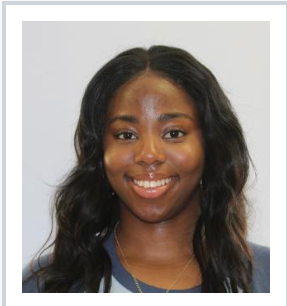
BIO
My name is Zikora Aliche. I am an international student from Nigeria. I graduated from Tallahassee State College and I attend Florida State University.
I major in Clinical Profession, and my future educational goal is to gain admission into medical school and complete my residency. I manage my online blog for extracurricular activities, sharing medical information and other topics.
DESCRIPTIVE DATABASE FOR COLLEGIATE RECOVERY PROGRAMS
Authors: Zikora Aliche, Dr. Chelsea ShoreStudent Major: Clinical Profession - (Interdisciplinary Medical Sciences)
Mentor: Dr. Chelsea Shore
Mentor's Department: Department of Educational Leadership and Policy Studies Mentor's College: The FSU Anne Spencer Daves College of Education, Health, and Human Sciences Co-Presenters: Katherine Baldwin, Ava Arch, Emily Arrendondo
Abstract
Collegiate Recovery Programs (CRPs) offer a supportive environment for students in recovery from substance abuse issues, promoting academic success, social well-being, and personal growth. A comprehensive database was developed by the Association of Recovery in Higher Education (ARHE) to consolidate existing research on CRPs within college populations. This project involved identifying and reviewing studies, coding key findings, and categorizing articles based on social justice considerations, theoretical frameworks, methodologies, etc. Additionally, research briefs were created to summarize thematic trends across the studies.
The published database, which includes approximately 140 articles, reveals a consistent satisfaction trend among students and staff regarding CRPs. The findings indicate that Collegiate Recovery Programs positively impact student life, including academic performance, social integration, and overall well-being. The data highlights the vital role of CRPs in promoting student success and emphasizes the necessity for ongoing funding and institutional support to enhance recovery-friendly campus environments.
Keywords: Substance Use Recovery, College student recovery
25th annual Undergraduate Research Symposium, April 1, 2025
Brianna Taylor Poster Session 2: 10:45 am - 11:45 am/ Poster #38
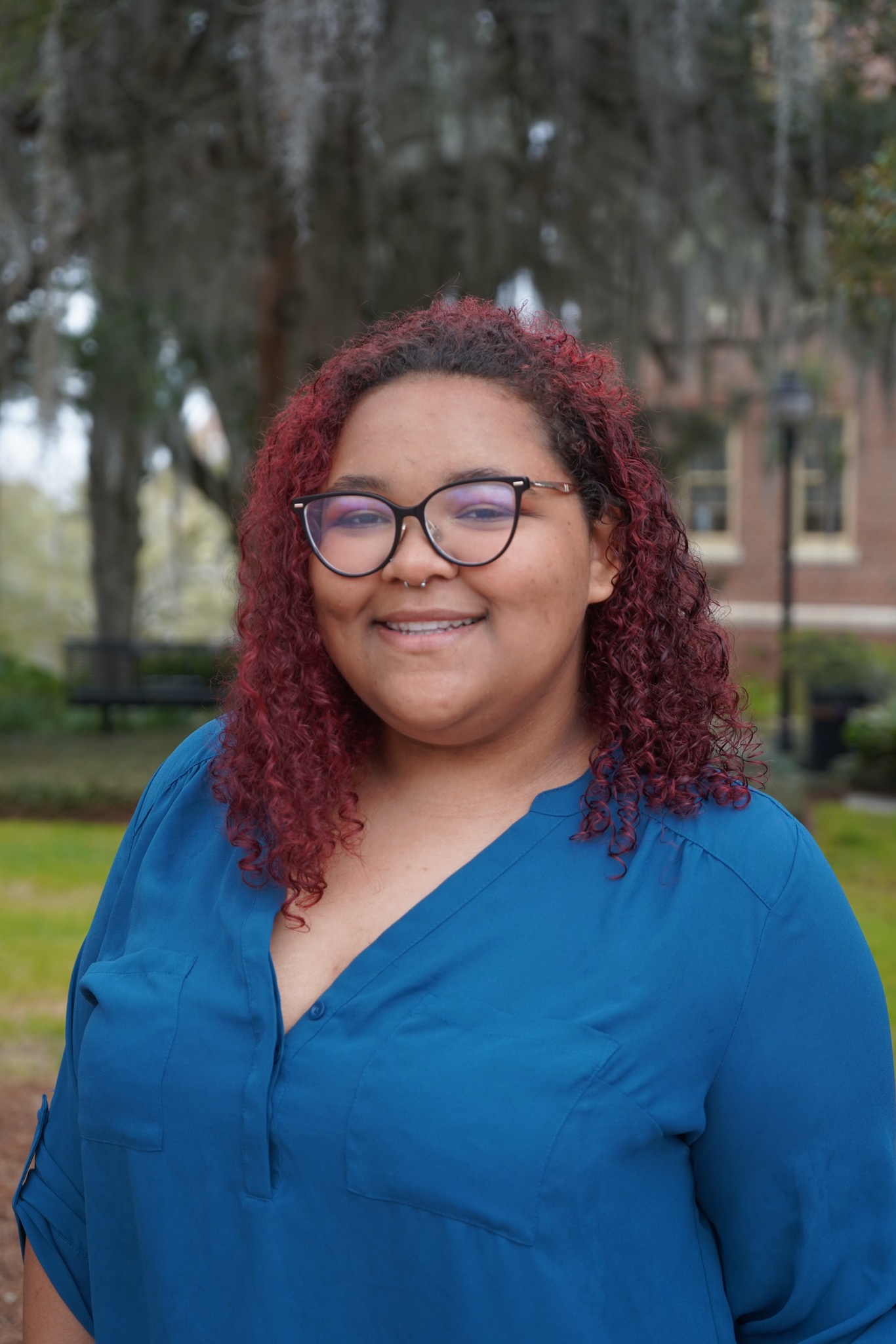
BIO
I am an honors student at FSU pursuing a dual degree in both Neuroscience and Spanish. I love learning about languages and cultures and in the future I want to incorporate my interests into medical research.
Representation of Women in Bollywood Films
Authors: Brianna Taylor, Rebecca PetersStudent Major: Cell and Molecular Neuroscience, Spanish
Mentor: Rebecca Peters
Mentor's Department: Religion Mentor's College: Arts and Sciences Co-Presenters: Theo Koren, Nicole Peterson
Abstract
This project is looking specifically at Bollywood films produced by female directors and how female characters in Bollywood films differ from characters in films produced by men. Female directors are somewhat rare in the Bollywood film industry, especially those who are backed by Indian film production companies. While not always the case, female directors tend to give more agency to female characters in Bollywood films. Women are less sexualized and seen as objects of desire and instead have dreams and aspirations. Each female character was categorized through a process called "film coding“, which looks at the number and qualities of female characters. A survey gets filled out about every major female character. Each survey for that specific character is then cross-referenced to make sure data is accurate and reported accordingly. Preliminary data reveals strong correlations between female directors and female characters having more “favorable” traits. These traits include any behavior that does not result in violence or abuse at the hands of another party, including but not limited not clothing choice, temperament, and reactions to confrontation. Men on average outnumber women in Bollywood films 6:1, this includes in the films themselves and set workers. In spaces where there is a female director on the set of Bollywood films, there is an increase in women working on film sets. With more women directing movies in the Bollywood film industry, audiences see female characters with more autonomy, and more women have jobs on film sets.
Keywords: Bollywood, Directors, Female Characters
25th annual Undergraduate Research Symposium, April 1, 2025
Colin Lewis Poster Session 4: 3:00 pm - 4:00 pm/ Poster #44
BIO
I'm in the second semester of my first year at FSU. I'm pursuing a dual degree in Biology and Anthropology with the plan to attend grad school.
Cryptic Evolution in the Neural Circuits of Pseudacris feriarum
Authors: Colin Lewis, Alan LemmonStudent Major: Biology, Anthropology
Mentor: Alan Lemmon
Mentor's Department: Scientific Computing Mentor's College: Arts and Science Co-Presenters:
Abstract
Little is known about the relationship between the evolution of the brain and behavior. Looking specifically at mating behavior, an examination of Pseudacris feriarum, a species of chorus frog, can shine a light on this relationship. Previous research has shown that relatively recently in its evolutionary history, populations of P. feriarum have become allopatrically separated from one another, with some populations overlapping with populations of other members of the genus Pseudacris. The resulting interaction has led to the evolution of mating behaviors to avoid hybridization. Using a particle swarm optimization technique, we identify neural circuit models that fit previously collected female preference data from female P. feriarum. One compelling question is: can two or more neural circuits with different configurations produce the same mating behavior? Examining allopatric populations in North Carolina and Alabama with this method allows us to see if there is any evidence of cryptic evolution (The process by which neural evolution could occur with no observable change in behavior.)
Keywords: Biology, Cryptic Evolution, Frogs, Neural Circuit, Divergence
25th annual Undergraduate Research Symposium, April 1, 2025
Jordyn Phillips Poster Session 4: 3:00 pm - 4:00 pm/ Poster #117

BIO
Hi, my name is Jordyn Phillips and I am from Houston, Texas. I am a finance major at FSU with aspirations to study business law post-grad and work in international corporate law. I have always had a interest in true crime, specifically in the media, and have advocated for gender equity throughout my high school and college experience, so I was naturally drawn to Ashley Johns and her research. I plan to advance in the research post-UROP and look forward to finding more patterns whilst coding; though our research is in infancy, there is so much value to understanding how gender inequities still exist in contemporary media.
A Qualitative Content Analysis of How “Snapped: Killer Couples” Portray Female Perpetrators Versus Their Male Partners
Authors: Jordyn Phillips, Ashley JohnsStudent Major: Finance
Mentor: Ashley Johns
Mentor's Department: Communication Department Mentor's College: FSU School of Communication Co-Presenters: Anarelis Galvez Marquez, Elizabeth Cortina
Abstract
Half of Americans consume true crime content with morbid human curiosity attributing to its popularity in the modern sphere. This research study delves into how the portrayals of men and women homicide perpetrators differ in the true crime show “Snapped: Killer Couples” and how directorial decisions (i.e., what the director felt was important to re-enact) shaped the gendered narrative of the perpetrators. The team utilized qualitative content analysis, creating a codebook to use when watching the show about the possible existing differences in male/female representation in criminal media. The codebook consisted of categories such as perpetrator gender, race, relationship to the partner in crime, homicide type, motivation, relationship to victim, competency, sexual orientation, and media frames. The research is still being conducted, but preliminary implications based on initial coding has shown that, even in the modern sense, women tend to be portrayed in true crime media as either villainous or victims. The villainous woman is demonized by the media and seen as monstrous, possibly seductive to their male partner; the victimized woman is subject to the will of her partner, an illness, or “hysteria” in response to outside masculine sources.
Keywords: Gender, Crime, Media
25th annual Undergraduate Research Symposium, April 1, 2025
May Sulema Poster Session 3: 1:45 pm - 2:45 pm/ Poster #204

BIO
May Sulema is a third-year student at Florida State University, majoring in Psychology and minoring in both Child Development and General Business. While her interests within the field of Psychology are broad, she is particularly interested in suicide and suicide prevention, as well as emotional regulation. May is actively involved in several research and leadership roles within Florida State University, including her work as a Peer Educator with RENEW, and as a Research Assistant in both the Joiner Lab and the March Lab. She is also a member of Kappa Alpha Theta, where she previously served as Mental Health Chairman. May plans to pursue graduate studies and continue her research in the field of Psychology.
A New Realm in Suicide Prevention: A Validation Study
Authors: May Sulema, Sara ProstkoStudent Major: Psychology
Mentor: Sara Prostko
Mentor's Department: Psychology Mentor's College: College of Arts and Sciences Co-Presenters:
Abstract
Suicide remains a leading cause of death and suicide rates in the United States continue to rise. Virtual reality (VR) offers a novel approach for studying suicide risk in a controlled and ethical environment. It allows researchers to experimentally manipulate key factors contributing to suicide behavior. However, past VR studies that used VR scenarios from pre-existing commercial games faced several challenges, including a limited representation of suicide methods and an inability to study decision-making processes. This study aims to validate four newly developed VR suicide scenarios – jumping, cutting, shooting, and overdosing – that have been designed to better reflect real-world methods of suicide in comparison to past VR suicide studies.
A sample of 110 undergraduate students will undergo the four novel VR suicide scenarios that will be randomized via a balanced Latin Square Design. Their decisions in the VR scenarios (i.e., VR suicide, aborted VR suicide, and safe option) as well as various suicide risk factors, including all key components to the Interpersonal Theory of Suicide (ITS), will be notated. Statistical analyses will be conducted using R, including descriptive statistics, chi-squares to compare realism and suicide-relevance across VR scenarios, and t-tests to examine differences between those who engaged in VR suicide and those who did not. Suicide attempt and aborted suicide attempt rates will be calculated across all four scenarios, and logistic regressions will be used to identify predictors of VR suicide engagement. Additionally, hierarchical logistic regressions will be performed to assess the ITS.
Keywords: Virtual Reality, Suicide, Suicide Prevention
25th annual Undergraduate Research Symposium, April 1, 2025
Olivia Olsen Poster Session 4: 3:00 pm - 4:00 pm/ Poster #190
BIO
Hello! I am currently a second-year honors student pursuing a double major in Political Science and Economics, with minors in French and General Business. My research interests include politics and international economies, specifically the interaction between the two and how these effects can create sustainable economic growth. I plan on studying abroad in France to complete a French language program, as being immersed in a different culture can create new global perspectives. In the future, I would like to pursue an MBA with a concentration in economics and eventually work in the financial sector.
The Carrot or the Stick? How Variation in Free Trade Agreements Affect the Size of the Informal Economy
Authors: Olivia Olsen, Chris GahaganStudent Major: Political Science/ Economics
Mentor: Chris Gahagan
Mentor's Department: Political Science Mentor's College: College of Social Sciences & Public Policy Co-Presenters: Cecilia Villarreal
Abstract
The worldwide informal economy consists of over two billion individuals and often includes the most dangerous and low-paying jobs, leading to many detrimental outcomes for both countries and individuals. Unfortunately, we know little about how international agreements shape informal employment. Conventional economic theories would suggest that informal employment in developing countries should decrease due to trade liberalization and increased foreign economic investment. However, empirical research has found mixed results, with some finding liberalization increases informality and others finding liberalization decreases informal work. To address this inconsistency, we develop a theory that considers variation within trade agreements, including the presence of labor provisions and the robustness of enforcement mechanisms. We argue that trade agreements with strong enforcement mechanisms coerce countries to improve labor rights, which in turn decreases the informal economy. We test our theory through matching within a difference-in-differences design with staggered treatment timing on a sample of countries from 1990-2020. Our preliminary results show that labor provisions in trade agreements play a meaningful role in reducing the size of the informal economy. Furthermore, we expect to find that this effect is driven by agreements with strong enforcement mechanisms compared to agreements with weak enforcement mechanisms. This work expands our knowledge on the causes and consequences of informal work while highlighting a pathway to sustainable growth.
Keywords: Informal Economy, Free Trade Agreements (FTAs), Labor Provisions, Enforcement Mechanisms
25th annual Undergraduate Research Symposium, April 1, 2025
Cassius D'Elena Poster Session 1: 9:30 am - 10:30 am/ Poster #66
BIO
I am a first year student at Florida State University. Coincidentally enough I was born and raised in St. Augustine, the location that is the focus of my research. I'm an Environmental Science student and when I'm not doing my schoolwork I like to surf, spend time in nature with my friends, and watch movies.
Ego & Power: A Look at the Relationship Between Gov. Patrick Tonyn and Royal General Augustine Prévost in 1777
Authors: Cassius D'Elena, Benjamin GunterStudent Major: Environmental Science
Mentor: Benjamin Gunter
Mentor's Department: Communications Mentor's College: School of Dance & Arts Co-Presenters:
Abstract
East Florida was governed by the British during the American Revolution. The capital of East Florida during this period was Saint Augustine, and its governor was Patrick Tonyn. Tonyn sought to fight back against the revolution, however, this never happened to the extent he desired. Why?
The answer is internal dissension in East Florida’s chain of command. The person most responsible for this dissension is Royal General Augustine Prévost. Prévost believed that he had full authority over the militia in East Florida. But Tonyn had his own militia, called the East Florida Rangers, and he would not relinquish control of these troops. My research looks at the relationship between Tonyn and Prévost and the power struggle for control over the East Florida militia and Rangers. By looking at the findings that have been published by authors researching East Florida under British governance and analyzing many primary sources, particularly a letter between Tonyn and Prévost, I was able to find two specific examples that illuminate the conflict between these two men. These findings can be used to explain other conflicts between Tonyn and Prévost, like the movement of troops. These findings can also help us paint a clearer picture of what British East Florida looked like during the Revolutionary War and how citizens of St. Augustine were affected by the actions of royal officials.
Keywords: American Revolution, St. Augustine, Dissent, History
25th annual Undergraduate Research Symposium, April 1, 2025
Jessa Maglio Poster Session 1: 9:30 am - 10:30 am / Poster #161
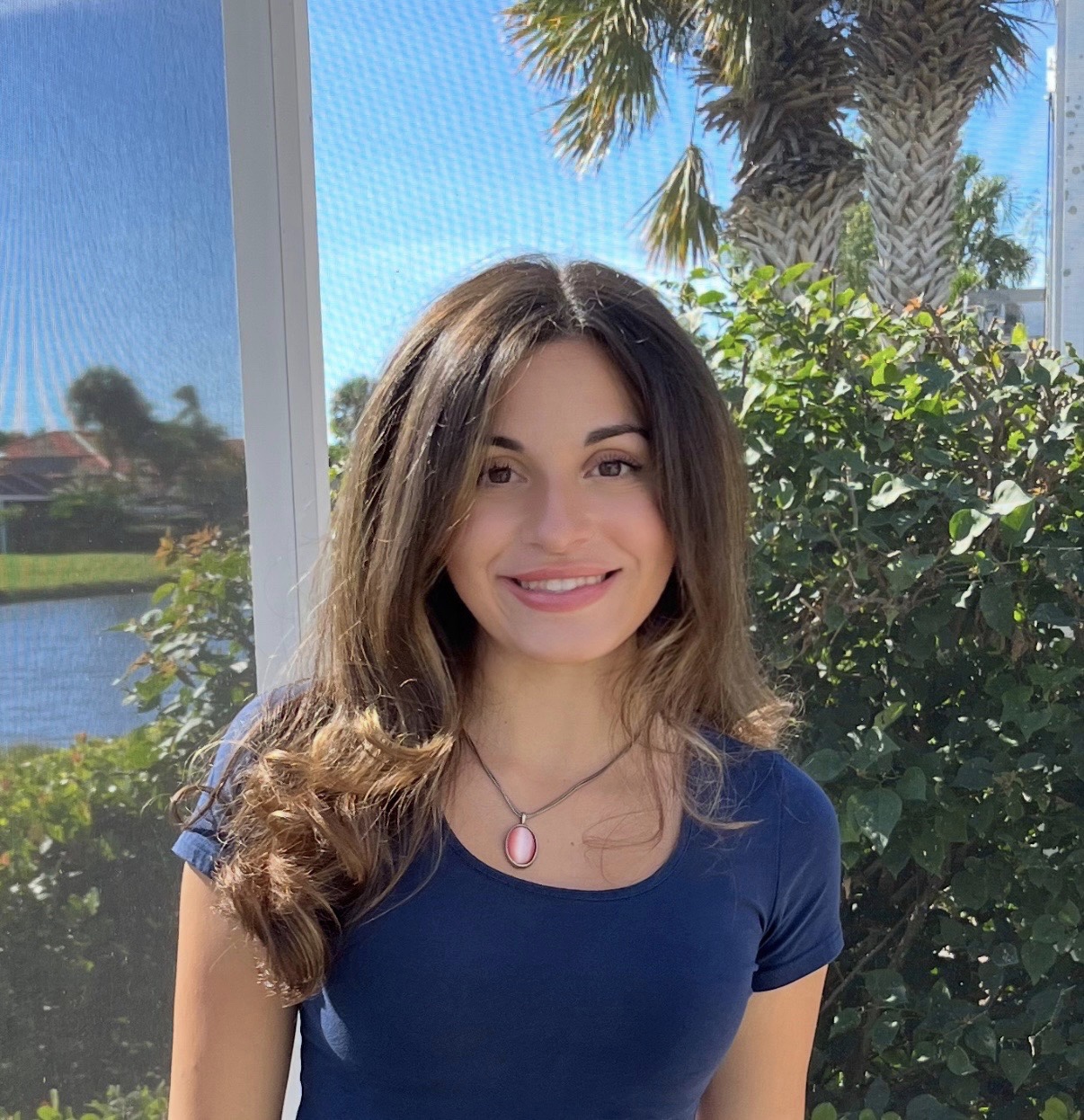
BIO
My name is Jessa Maglio. I am a junior majoring in Biology with a minor in Chemistry. My passion for science, healthcare, and research stems from my analytical nature and desire to address the key health challenges within our communities. I currently work as a research assistant on an NIH-funded program focused on healthy aging and neurodegenerative disorders, including Alzheimer’s Disease.
Arc1 functions in insulin producing cells to regulate sleep in Drosophila
Authors: Jessa Maglio, Dr. Elizabeth BrownStudent Major: Biological Science
Mentor: Dr. Elizabeth Brown
Mentor's Department: Department of Biological Science Mentor's College: College of Arts and Sciences Co-Presenters: Kaitlyn Pamplona
Abstract
Neural regulation of sleep and metabolic homeostasis are critical in many aspects of human health. Despite extensive epidemiological evidence linking sleep dysregulation with obesity, diabetes, and metabolic syndrome, little is known about the neural and molecular basis for the integration of sleep and metabolic function. The gene Activity regulated cytoskeleton protein 1 (Arc1) has been linked to synaptic plasticity and metabolic function, which play crucial roles in sleep regulation and raise the possibility that it functions to control these processes. Here we characterize the effects of Arc1 on sleep duration. Flies lacking Arc1 significantly increase sleep duration by increasing the length of individual sleep episodes, raising the possibility that loss of Arc1 promotes deep sleep. The effects of Arc1 on sleep duration can be localized to neurons expressing the Drosophila insulin-like peptide (Dilp2), which has been previously implicated in the metabolic regulation of sleep depth. Silencing expression of Arc1 in these neurons significantly increases sleep duration, phenocopying Arc1 mutants, while overexpression of Arc1 significantly decreased sleep duration. We also find that Arc1 neurons are acutely required for increased sleep duration. A key hallmark of sleep depth in mammals and flies is a reduction in metabolic rate during sleep. We are currently investigating whether Arc1 functions in Dilp2-expressing neurons to regulate metabolic rate during sleep. Together, these findings will shed light on the role of Arc1 function in insulin-producing cells in sleep quality in Drosophila. Overall, this work contributes to our understanding of Arc1 function in the regulation of sleep.
Keywords: Aging, Neurodegeneration, Sleep, Biology
25th annual Undergraduate Research Symposium, April 1, 2025
Garrett Di Scala Poster Session 3: 1:45 pm - 2:45 pm/ Poster #191

BIO
I’m Garrett Di Scala, an undergraduate student from Ocala Florida, pursuing a B.A. in Media and Communications with a minor in Political Science. My research focuses on intermarriage and women’s resistance during the Holocaust, exploring the complexities of identity, resilience, and survival under Nazi rule. This project is part of a year-long collaboration with Donald Gjoka and Danielle Wirsansky, where I aim to amplify untold stories of courage and defiance. After graduation, I plan to pursue a career in law and advocacy, using research and storytelling to spark social change.
Exploring the Role of Intermarriage and Resilience During the Holocaust
Authors: Garrett Di Scala, Donald GjokaStudent Major: Media and Communications Studies
Mentor: Donald Gjoka
Mentor's Department: Department of History Mentor's College: Florida State University Co-Presenters:
Abstract
This research builds on Bound by Love, a documentary by Danielle Wirsansky and Donald Gjoka, which examines the role of intermarriage during the Holocaust. The documentary’s portrayal of mixed-marriage families as a challenge to Nazi racial ideology directly informs the research questions: How did intermarriage influence survival and resilience among Jewish communities, and how did Nazi policies impact intermarried couples and their families? Expanding on the documentary’s insights, this study explores the protective power of cross-cultural bonds amidst systemic persecution. Methodologically, the research employs documentary filmmaking techniques, including interviews with descendants of intermarried couples and the editing of archival footage, to weave personal narratives into the historical record. These methods highlight intermarriage's historical significance as a lens for understanding resilience. By blending historical analysis with documentary storytelling, this project seeks to highlight the multifaceted role of intermarriage during the Holocaust. It highlights intermarriage not only as a personal decision but also as a source of resilience and defiance, creating a nuanced perspective on the Holocaust and the broader understanding of cross-cultural relationships in times of crisis.
Keywords: Intermarriage, Holocaust, Documentary, Rosenstrasse, Protest
25th annual Undergraduate Research Symposium, April 1, 2025
Ava Griner Poster Session 4: 3:00 pm - 4:00 pm/ Poster #242

BIO
I am a first year behavioral neuroscience and music dual-degree seeking student from Sarasota, Florida. My career goal is to research the intersection between these two fields while teaching at a university. However, I also find gender and communication studies fascinating and incredibly relevant! This interest drew me to the project I am currently working on, which involves studying advertisements to determine the portrayals of gender and household responsibility within them. Research, for me, is a tool that can be used to promote positive societal change, and I believe that examining gender/racial stereotypes and expectations within our society creates room for that growth.
Gendered Depictions of Household Care Responsibilities in Advertisements: A Quantitative Content Analysis
Authors: Ava Griner, Alessandra Noli PeschieraStudent Major: Behavioral Neuroscience/Music
Mentor: Alessandra Noli Peschiera
Mentor's Department: Center for HIspanic Marketing Communication Mentor's College: College of Communication and Information Co-Presenters: Kiara Felix, Payton Vazquez
Abstract
Social learning theory and social cognitive theory both state that human behavior is greatly impacted by the representation of behaviors around them. The purpose of this study is to determine the representation of and expectations for behavior of demographic groups such as gender and race in household cleaning product advertisements. Quantitative content analyses are commonly used to determine the general distribution of characteristics across a set of media. Here, demographic based role assignment bias in cleaning product advertisements was measured using such an analysis. A reliable test was first built by a group of three coders through four rounds of practice coding and one round of reliability coding. Then, the advertisements to be featured in the final data analysis were coded and subsequently assessed to determine broader patterns. Bias in these advertisements has the potential to shape viewer’s expectations of individuals that fall into those demographics, thus pushing certain people into homemaker roles. There is a history in the United States of expecting women to be homemakers, and household product advertisements of the recent past consistently placed women characters into homemaker roles. It is necessary, then, to determine whether this pattern still exists, or if modern social justice movements have encouraged advertisement companies to produce a more diverse cast of characters, thus diversifying thought among viewers. Once the distribution of cleaning product advertisements is determined, it would be reasonable to pursue other forms of media, such as television and movies to truly understand the media atmosphere shaping American minds.
Keywords: Gender, Race, Advertisements, Communications
25th annual Undergraduate Research Symposium, April 1, 2025
Katherine Miller Poster Session 1: 9:30 am - 10:30 am/ Poster #144

BIO
Katherine Miller is a first-year mechanical engineering student at the FAMU-FSU College of Engineering from Clearwater, FL. She has a strong interest in space exploration, with a research focus on investigating materials for effective spacecraft lubrication. Outside of research, Katherine is an accomplished musician, playing the flute and bagpipes as a member of the FSU Marching Chiefs and the City of Dunedin Grade Two Pipe Band. After completing her undergrauate studies, Katherine plans to complete a master's degree in aerospace engineering and embark on a career advancing spacecraft technology.
Tribological Performance of Diamond-Like Carbon (DLC) in Extreme Environments
Authors: Katherine Miller, Adam DelongStudent Major: Mechanical Engineering
Mentor: Adam Delong
Mentor's Department: Mechaical Engineering Mentor's College: FAMU-FSU College of Engineering Co-Presenters:
Abstract
Effectively lubricating spacecraft has posed a major challenge for scientists and engineers for many years. Due to extreme environmental conditions including varying temperatures, radiation exposure, and microgravity, many traditional lubricants fail to function properly in this realm. As spacecraft must be able to operate for decades without repair or maintenance, scientists rely on solid lubricants for durability and protection in these extreme conditions. Dry film lubricants are solid materials applied to surfaces in thin layers to reduce friction and wear between surfaces. Diamond-Like Carbon (DLC) is an advantageous solid lubricant for aerospace applications due to its high hardness, low friction, and its stability across a wide temperature range. This experiment seeks to evaluate the integrity of the tribological properties of DLC in extreme temperature environments. DLC was deposited on 440C stainless steel substrates via chemical vapor deposition (CVD). A custom linear reciprocating tribometer was used to conduct friction and wear experiments to measure the performance of these coatings at 20 and -60°C. Finally, a white light interferometer was used to image and analyze the surface of the samples where friction and wear experiments were conducted. A 3D rendering of the surface is made and the total volume of material removed from the surface is measured. This poster documents the effectiveness of DLC coated 440C stainless steel in a cold and inert environment.
Keywords: Engineering, Aerospace, Friction, Lubrication, Tribology


